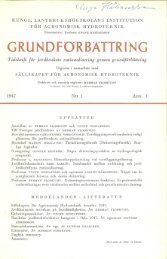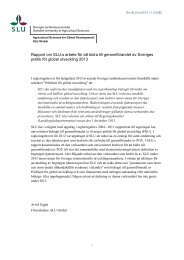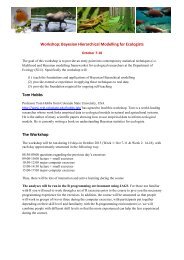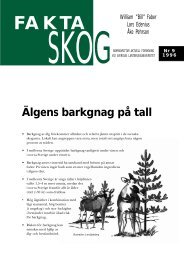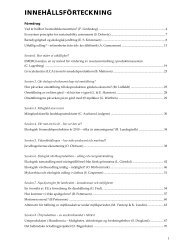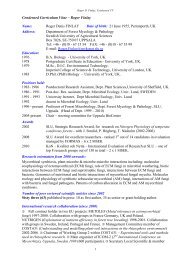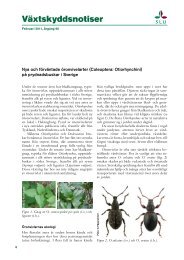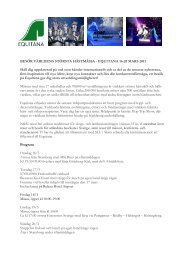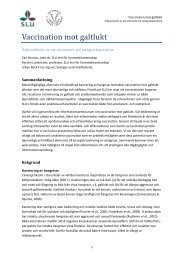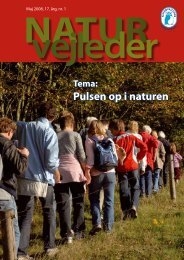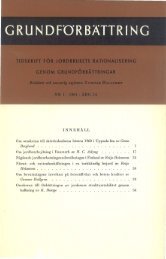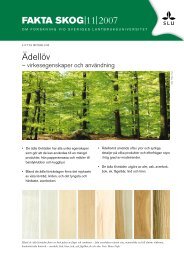Bryophytes and lichens in different types of forest set-asides in ... - SLU
Bryophytes and lichens in different types of forest set-asides in ... - SLU
Bryophytes and lichens in different types of forest set-asides in ... - SLU
Create successful ePaper yourself
Turn your PDF publications into a flip-book with our unique Google optimized e-Paper software.
Forest Ecology <strong>and</strong> Management 242 (2007) 374–390<br />
www.elsevier.com/locate/foreco<br />
<strong>Bryophytes</strong> <strong>and</strong> <strong>lichens</strong> <strong>in</strong> <strong>different</strong> <strong>types</strong> <strong>of</strong> <strong>forest</strong><br />
<strong>set</strong>-<strong>asides</strong> <strong>in</strong> boreal Sweden<br />
Kar<strong>in</strong> Perhans a, *, Lena Gustafsson a , Fredrik Jonsson b , Ulrika Nord<strong>in</strong> b , Henrik Weibull c<br />
a Department <strong>of</strong> Ecology, Swedish University <strong>of</strong> Agricultural Sciences, Box 7002, SE-750 07 Uppsala, Sweden<br />
b Ede 1400, SE-830 47 Trångsviken, Sweden<br />
c Naturcentrum AB, Str<strong>and</strong>torget 3, SE-444 30 Stenungsund, Sweden<br />
Received 8 June 2006; received <strong>in</strong> revised form 20 November 2006; accepted 21 January 2007<br />
Abstract<br />
Sett<strong>in</strong>g aside <strong>forest</strong> l<strong>and</strong> is practiced globally <strong>and</strong> is <strong>of</strong> vital importance to the preservation <strong>of</strong> <strong>forest</strong> biodiversity. As detailed species <strong>in</strong>ventories<br />
rarely precede the establishment <strong>of</strong> <strong>set</strong>-<strong>asides</strong>, empirical studies on the species content <strong>of</strong> <strong>different</strong> <strong>set</strong>-aside <strong>types</strong> are needed, <strong>in</strong> order to evaluate<br />
their conservation relevance <strong>and</strong> to design efficient conservation strategies. Here, we compared the biodiversity value per unit area <strong>of</strong> three <strong>types</strong> <strong>of</strong><br />
<strong>set</strong>-<strong>asides</strong>, common <strong>in</strong> boreal Europe: nature reserves, key habitats <strong>and</strong> retention groups on clear-cuts, <strong>and</strong> we also <strong>in</strong>cluded old managed <strong>forest</strong>s as<br />
reference sites. We surveyed bryophytes on all substrates <strong>and</strong> <strong>lichens</strong> grow<strong>in</strong>g on spruce <strong>in</strong> spruce-dom<strong>in</strong>ated <strong>forest</strong>s <strong>in</strong> middle boreal Sweden <strong>and</strong><br />
<strong>in</strong> total 252 bryophytes <strong>and</strong> 176 <strong>lichens</strong> were found. For bryophytes the number <strong>of</strong> species, as well as the number <strong>of</strong> red-listed species, per unit area<br />
was higher <strong>in</strong> key habitats than <strong>in</strong> retention groups <strong>and</strong> old managed <strong>forest</strong>s, while <strong>in</strong>termediate <strong>in</strong> nature reserves. As the complementarity between<br />
areas was greatest <strong>in</strong> key habitats, the total number <strong>of</strong> bryophyte species found was by far the highest <strong>in</strong> this <strong>set</strong>-aside type. For <strong>lichens</strong> the patterns<br />
were similar but the differences much less pronounced. Site selection methods based on l<strong>in</strong>ear programm<strong>in</strong>g demonstrated that key habitats also<br />
played the most important role <strong>in</strong> represent<strong>in</strong>g the surveyed taxa effectively but that the value <strong>of</strong> nature reserves <strong>in</strong>creased when multiple<br />
representations <strong>of</strong> each species were required. The study shows that the richness <strong>and</strong> composition <strong>of</strong> bryophytes <strong>and</strong> <strong>lichens</strong> differ between the<br />
three <strong>set</strong>-aside <strong>types</strong> <strong>and</strong> consequently, the outcome <strong>of</strong> large-scale conservation strategies based on anyone type would be <strong>different</strong>. At present, key<br />
habitats st<strong>and</strong> out as core areas <strong>of</strong> high diversity <strong>in</strong> the <strong>forest</strong> l<strong>and</strong>scape but it is important also to acknowledge the temporal dynamics <strong>of</strong> the <strong>forest</strong><br />
l<strong>and</strong>scape <strong>and</strong> how the capacity <strong>of</strong> each <strong>set</strong>-aside type to host species can be expected to change over time.<br />
# 2007 Elsevier B.V. All rights reserved.<br />
Keywords: Nature reserve; Woodl<strong>and</strong> key habitat; Retention group; Red-listed species; Indicator species; Conservation strategy<br />
1. Introduction<br />
The establishment <strong>of</strong> <strong>set</strong>-<strong>asides</strong> for conservation purposes is<br />
practiced <strong>in</strong> all parts <strong>of</strong> the world, with 11% <strong>of</strong> the global <strong>forest</strong><br />
area designated for the preservation <strong>of</strong> biodiversity (FAO,<br />
2006). There has long been a theoretical <strong>in</strong>terest <strong>in</strong> ecology on<br />
how the size <strong>and</strong> spatial configuration <strong>of</strong> patches affect<br />
communities <strong>and</strong> populations (e.g. MacArthur <strong>and</strong> Wilson,<br />
1967; Diamond, 1975; Hanski, 1999), <strong>and</strong> this has been l<strong>in</strong>ked<br />
to nature conservation, with substantial practical implications.<br />
Further, <strong>in</strong> the last 20 years there has been an <strong>in</strong>creas<strong>in</strong>g focus<br />
on systematic conservation plann<strong>in</strong>g, i.e. how to select<br />
protected areas <strong>in</strong> a way that captures biodiversity as efficiently<br />
* Correspond<strong>in</strong>g author. Tel.: +46 18 67 22 67; fax: +46 18 67 35 37.<br />
E-mail address: kar<strong>in</strong>.perhans@nvb.slu.se (K. Perhans).<br />
as possible (e.g. Margules <strong>and</strong> Pressey, 2000). But, there is still<br />
a lack <strong>of</strong> empirical studies <strong>in</strong> which comparisons regard<strong>in</strong>g<br />
biodiversity are made between <strong>different</strong> <strong>types</strong> <strong>of</strong> <strong>set</strong>-<strong>asides</strong>.<br />
Because large f<strong>in</strong>ancial resources are spent on biodiversity<br />
preservation <strong>and</strong> protection <strong>of</strong> <strong>forest</strong> l<strong>and</strong>, this research topic<br />
warrants more attention.<br />
In Sc<strong>and</strong><strong>in</strong>avia, <strong>in</strong>tensification <strong>of</strong> <strong>forest</strong>ry dur<strong>in</strong>g the last 100<br />
years has led to even-aged, more fragmented <strong>forest</strong>s with<br />
shorter rotation periods <strong>and</strong> a scarcity <strong>of</strong> dead wood (Esseen<br />
et al., 1997; Östlund et al., 1997). This has resulted <strong>in</strong> small or<br />
decl<strong>in</strong><strong>in</strong>g populations <strong>of</strong> almost 2000 <strong>forest</strong>-liv<strong>in</strong>g species<br />
(Gärdenfors, 2005) <strong>and</strong> <strong>in</strong> recognition <strong>of</strong> this, <strong>in</strong>creas<strong>in</strong>g<br />
amounts <strong>of</strong> <strong>forest</strong> l<strong>and</strong> have been <strong>set</strong>-aside dur<strong>in</strong>g the last<br />
decades <strong>and</strong> new management techniques are be<strong>in</strong>g employed<br />
<strong>in</strong> order to satisfy the needs <strong>of</strong> the flora <strong>and</strong> fauna. Today 4% <strong>of</strong><br />
the productive <strong>forest</strong> l<strong>and</strong> <strong>in</strong> Sweden is protected by law,<br />
although only 1% <strong>of</strong> this is outside the mounta<strong>in</strong> <strong>forest</strong><br />
0378-1127/$ – see front matter # 2007 Elsevier B.V. All rights reserved.<br />
doi:10.1016/j.foreco.2007.01.055
K. Perhans et al. / Forest Ecology <strong>and</strong> Management 242 (2007) 374–390 375<br />
(Svedlund <strong>and</strong> Löfgren, 2003). This is a low proportion<br />
compared to other countries where <strong>forest</strong> is a dom<strong>in</strong>at<strong>in</strong>g l<strong>and</strong><br />
class (FAO, 2006). On the other h<strong>and</strong>, the protection regulations<br />
are strictly obeyed <strong>and</strong> thus the <strong>set</strong>-aside areas are normally<br />
completely allocated to biodiversity conservation.<br />
There are several <strong>types</strong> <strong>of</strong> <strong>forest</strong> <strong>set</strong>-<strong>asides</strong> <strong>in</strong> Sweden as well<br />
as <strong>in</strong> other parts <strong>of</strong> boreal Europe, differ<strong>in</strong>g <strong>in</strong> establishment<br />
form, legal status <strong>and</strong> size. Nature reserves represent the most<br />
common type, with about 2500 established from 1967 to 2003,<br />
cover<strong>in</strong>g 850,000 ha <strong>of</strong> productive <strong>forest</strong> l<strong>and</strong> (Svedlund <strong>and</strong><br />
Löfgren, 2003). The mean size <strong>of</strong> <strong>forest</strong>ed or partly <strong>forest</strong>ed<br />
nature reserves is 130 ha, but the size varies from a few hectares<br />
up to several thous<strong>and</strong>s <strong>of</strong> hectares. Most reserves are<br />
established to protect biodiversity, although there can also be<br />
recreational purposes. A majority <strong>of</strong> nature reserves have a<br />
strong legal protection <strong>and</strong> timber harvest<strong>in</strong>g is normally<br />
prohibited.<br />
Lately, the so-called woodl<strong>and</strong> key habitats (hereafter called<br />
‘‘key habitats’’) have come to play an important role <strong>in</strong><br />
conservation. The Swedish Forest Agency <strong>in</strong>itiated a survey <strong>in</strong><br />
1993 on all <strong>forest</strong> hold<strong>in</strong>gs 5000 ha, the<br />
<strong>forest</strong> owner is responsible for carry<strong>in</strong>g out the <strong>in</strong>ventory,<br />
supervised by the Swedish Forest Agency. Accord<strong>in</strong>g to the<br />
def<strong>in</strong>ition, a key habitat is a <strong>forest</strong> area <strong>of</strong> great importance to<br />
sensitive flora <strong>and</strong> fauna because <strong>of</strong> its structural, historical <strong>and</strong><br />
physical characteristics <strong>and</strong> should conta<strong>in</strong> or be expected to<br />
conta<strong>in</strong> red-listed species (Nitare <strong>and</strong> Norén, 1992; Norén et al.,<br />
2002). The <strong>in</strong>ventory <strong>of</strong> key habitats is based ma<strong>in</strong>ly on<br />
structural characteristics <strong>and</strong> on a <strong>set</strong> <strong>of</strong> <strong>in</strong>dicator species <strong>of</strong><br />
bryophytes, <strong>lichens</strong> <strong>and</strong> fungi, supposed to <strong>in</strong>dicate <strong>forest</strong>s with<br />
high conservation value. The key habitats are classified <strong>in</strong>to 51<br />
<strong>different</strong> biotope <strong>types</strong>, <strong>of</strong> which coniferous <strong>forest</strong>, coniferous<br />
wetl<strong>and</strong> <strong>forest</strong> <strong>and</strong> water-associated habitats are the most<br />
common <strong>types</strong> <strong>in</strong> middle Sweden (Swedish Forest Agency,<br />
2006). Similar <strong>in</strong>ventories <strong>of</strong> key habitats have recently been<br />
conducted <strong>in</strong> Denmark, Norway, F<strong>in</strong>l<strong>and</strong>, Estonia, Latvia <strong>and</strong><br />
Lithuania. Key habitats are generally small with a mean size <strong>of</strong><br />
3.2 ha (Swedish Forest Agency, 2006). Until 2006, about<br />
56,000 key habitats were found on private l<strong>and</strong>, correspond<strong>in</strong>g<br />
to an area <strong>of</strong> 150,000 ha, or slightly more than 1%, <strong>of</strong> the<br />
productive <strong>forest</strong>l<strong>and</strong>. Key habitats are not protected by law, but<br />
the <strong>forest</strong> owner must consult with the Swedish Forest Agency<br />
before logg<strong>in</strong>g. Accord<strong>in</strong>g to the <strong>forest</strong> certification schemes<br />
FSC (Forest Stewardship Council) <strong>and</strong> PEFC (Programme for<br />
the Endorsement <strong>of</strong> Forest Certification schemes), <strong>forest</strong><br />
owners should voluntarily <strong>set</strong> aside 5% <strong>of</strong> their productive<br />
<strong>forest</strong> l<strong>and</strong>, <strong>and</strong> where key habitats are present they are<br />
normally prioritized. Additionally, due to the above mentioned<br />
certification schemes <strong>and</strong> a strong public op<strong>in</strong>ion, timber from<br />
key habitats is virtually unsalable. Therefore, here we classify<br />
key habitats as <strong>set</strong>-<strong>asides</strong>.<br />
Increas<strong>in</strong>gly, small groups <strong>of</strong> liv<strong>in</strong>g trees (hereafter called<br />
‘‘retention groups’’) are systematically left on clear-cuts as a<br />
way to reduce the negative impacts <strong>of</strong> clear-cutt<strong>in</strong>g on<br />
biodiversity (Hazell <strong>and</strong> Gustafsson, 1999). On average<br />
3.1% <strong>of</strong> the total clear-cut area was left as groups <strong>of</strong> trees<br />
(0.6%), groups <strong>of</strong> young trees (0.5%), buffer zones (0.9%) <strong>and</strong><br />
sensitive habitats (1.1%) <strong>in</strong> Sweden between 1995 <strong>and</strong> 1997<br />
(Swedish Forest Agency, 2006). Also <strong>in</strong> e.g. F<strong>in</strong>l<strong>and</strong> (Vanha-<br />
Majamaa <strong>and</strong> Jalonen, 2001) <strong>and</strong> the USA (Aubry et al., 1999)<br />
retention <strong>of</strong> trees at f<strong>in</strong>al harvest is a common practice.<br />
Retention groups are <strong>in</strong>tended as short-term refugia for many<br />
organisms over the regeneration phase <strong>and</strong> can become sources<br />
<strong>of</strong> dispersal <strong>in</strong>to the grow<strong>in</strong>g <strong>forest</strong> (Esseen et al., 1997;<br />
Frankl<strong>in</strong> et al., 2000). However, the capacity <strong>of</strong> retention groups<br />
to support biodiversity is poorly known (but see Vanha-<br />
Majamaa <strong>and</strong> Jalonen, 2001; Nelson <strong>and</strong> Halpern, 2005).<br />
As large-scale species <strong>in</strong>ventories are expensive, <strong>forest</strong> <strong>set</strong><strong>asides</strong><br />
are generally identified on the basis <strong>of</strong> st<strong>and</strong><br />
characteristics or <strong>in</strong>dicator species. Thus, to a large extent<br />
the actual species diversity <strong>in</strong> the <strong>set</strong>-<strong>asides</strong> is normally<br />
unknown. Several comparisons have been made between <strong>set</strong>aside<br />
<strong>and</strong> non <strong>set</strong>-aside areas, e.g. for birds <strong>in</strong> F<strong>in</strong>l<strong>and</strong> (Virkkala<br />
et al., 1994), saproxylic beetles <strong>in</strong> Norway (Sverdrup-<br />
Thygeson, 2002) <strong>and</strong> vascular plants <strong>in</strong> South Africa<br />
(Shackleton, 2000). But, we know <strong>of</strong> no study, <strong>in</strong> Sc<strong>and</strong><strong>in</strong>avia<br />
or elsewhere, <strong>in</strong> which extensive field <strong>in</strong>ventory <strong>of</strong> species has<br />
been made <strong>in</strong> <strong>different</strong> <strong>types</strong> <strong>of</strong> <strong>set</strong>-<strong>asides</strong>, for the purpose <strong>of</strong><br />
comparison <strong>and</strong> evaluation <strong>of</strong> their biodiversity quality (here<br />
def<strong>in</strong>ed as total number <strong>of</strong> species <strong>and</strong> presence <strong>of</strong> species <strong>of</strong><br />
conservation <strong>in</strong>terest). Further, there is a scarcity <strong>of</strong> full-range<br />
data on less known but species-rich organism groups like<br />
bryophytes <strong>and</strong> <strong>lichens</strong>. Many <strong>of</strong> the conservation-oriented<br />
studies performed on these groups have focused on red-listed<br />
species (e.g. Johansson <strong>and</strong> Gustafsson, 2001; Gustafsson et al.,<br />
2004). <strong>Bryophytes</strong> <strong>and</strong> <strong>lichens</strong> have been given <strong>in</strong>creas<strong>in</strong>g<br />
attention with<strong>in</strong> conservation s<strong>in</strong>ce they are considered<br />
sensitive to <strong>forest</strong>ry operations, <strong>and</strong> <strong>in</strong> northern Europe they<br />
are used as <strong>in</strong>dicators <strong>of</strong> <strong>forest</strong> sites valuable to biodiversity<br />
(Hall<strong>in</strong>gbäck <strong>and</strong> Weibull, 1996; Esseen et al., 1997).<br />
The aim <strong>of</strong> this study, which is part <strong>of</strong> a research project on<br />
cost-effective reserve strategies <strong>in</strong> boreal Sweden, was to<br />
compare the biodiversity quality per unit area <strong>in</strong> three <strong>types</strong> <strong>of</strong><br />
<strong>forest</strong> <strong>set</strong>-<strong>asides</strong>: nature reserves, key habitats <strong>and</strong> retention<br />
groups, as well as <strong>in</strong> old managed <strong>forest</strong>s. <strong>Bryophytes</strong> <strong>and</strong><br />
<strong>lichens</strong> were used as assessment tools <strong>and</strong> we focused on<br />
total species richness <strong>and</strong> on two sub-groups <strong>of</strong> species <strong>of</strong><br />
conservation <strong>in</strong>terest: red-listed species <strong>and</strong> <strong>in</strong>dicator species,<br />
which are assumed to <strong>in</strong>dicate <strong>forest</strong>s with high conservation<br />
value.<br />
2. Methods<br />
2.1. Study area<br />
The <strong>in</strong>ventory was made <strong>in</strong> the northern part <strong>of</strong> Gävleborg<br />
county (Fig. 1), with<strong>in</strong> the middle boreal vegetation zone (Ahti<br />
et al., 1968) <strong>in</strong> Sweden. The study area is approximately<br />
150 km 150 km, central position 61845 0 N, 16810 0 E. The<br />
elevation ranges from 80 m above sea level <strong>in</strong> the eastern parts<br />
to 490 m above sea level <strong>in</strong> the northwestern part. The <strong>forest</strong>s,<br />
which cover 80% <strong>of</strong> Gävleborg county, consist ma<strong>in</strong>ly <strong>of</strong>
376<br />
K. Perhans et al. / Forest Ecology <strong>and</strong> Management 242 (2007) 374–390<br />
habitats were r<strong>and</strong>omly selected from all <strong>forest</strong> patches which,<br />
accord<strong>in</strong>g to wRESEx, fulfilled the above stated criteria.<br />
A retention group was <strong>in</strong> this study def<strong>in</strong>ed as an isl<strong>and</strong> <strong>of</strong><br />
<strong>forest</strong>, larger than 25 m 25 m but not larger than 0.5 ha,<br />
completely surrounded by clear-cut area. Due to errors <strong>in</strong> the<br />
satellite <strong>in</strong>terpretation <strong>of</strong> small areas, a sufficient number <strong>of</strong><br />
retention groups could not be identified <strong>in</strong> wRESEx. Instead,<br />
we gathered <strong>in</strong>formation from the satellite map system <strong>of</strong> the<br />
Swedish Forest Agency <strong>and</strong> through <strong>in</strong>terviews with <strong>forest</strong><br />
personnel at the Swedish Forest Agency <strong>and</strong> at the <strong>forest</strong><br />
company Stora Enso. The time s<strong>in</strong>ce creation <strong>of</strong> the retention<br />
groups varied but was always less than 15 years. The old<br />
managed <strong>forest</strong> sites were selected by r<strong>and</strong>omly sampl<strong>in</strong>g<br />
cross<strong>in</strong>gs <strong>of</strong> divid<strong>in</strong>g l<strong>in</strong>es on a 10 km 10 km grid cover<strong>in</strong>g<br />
the study area, <strong>and</strong> from there search<strong>in</strong>g <strong>in</strong> a r<strong>and</strong>om direction.<br />
The first <strong>forest</strong> patch that fulfilled the criteria, <strong>and</strong> was not<br />
with<strong>in</strong> the boundaries <strong>of</strong> a nature reserve or a key habitat, was<br />
selected as an old managed <strong>forest</strong> site.<br />
Fig. 1. Location <strong>of</strong> field study <strong>in</strong> boreal Sweden. Magnified area shows northern<br />
part <strong>of</strong> Gävleborg county <strong>and</strong> the distribution <strong>of</strong> the 80 study plots. (&) Key<br />
habitat; (&) nature reserve; (*) old managed <strong>forest</strong>; (*) retention group.<br />
Norway spruce (Picea abies) <strong>and</strong> Scots p<strong>in</strong>e (P<strong>in</strong>us sylvestris)<br />
with about 10% deciduous trees, ma<strong>in</strong>ly birch (Betula pendula<br />
<strong>and</strong> B. pubescens)(Swedish Forest Agency, 2006). Key habitats<br />
constitute 0.7% (5500 ha) <strong>of</strong> the productive <strong>forest</strong> on private<br />
l<strong>and</strong> <strong>and</strong> nature reserves 0.6% (9100 ha) <strong>of</strong> the total area <strong>of</strong><br />
productive <strong>forest</strong> l<strong>and</strong> <strong>in</strong> the study area (Swedish Forest<br />
Agency, 2006).<br />
2.2. Selection <strong>of</strong> study sites<br />
We r<strong>and</strong>omly selected a total <strong>of</strong> 80 sites (areas with similar<br />
<strong>forest</strong> composition <strong>and</strong> characteristics), 20 <strong>in</strong> each <strong>of</strong> the 4<br />
<strong>forest</strong> categories: nature reserves, key habitats, retention groups<br />
<strong>and</strong> old managed <strong>forest</strong>s (Fig. 1). Information on the location <strong>of</strong><br />
exist<strong>in</strong>g nature reserves, as well as areas <strong>in</strong> the process <strong>of</strong><br />
becom<strong>in</strong>g nature reserves, was provided by the county<br />
adm<strong>in</strong>istrative board <strong>of</strong> Gävleborg, <strong>and</strong> <strong>in</strong>formation on key<br />
habitats were obta<strong>in</strong>ed from the Swedish Forest Agency <strong>and</strong><br />
from the <strong>forest</strong> company Holmen Skog.<br />
The selection <strong>of</strong> sites was made by us<strong>in</strong>g the satellite map<br />
‘‘wRESEx’’ (Angelstam et al., 2003), which divides all <strong>forest</strong><br />
l<strong>and</strong> <strong>in</strong> Gävleborg county <strong>in</strong>to 33 classes accord<strong>in</strong>g to dom<strong>in</strong>ant<br />
tree species <strong>and</strong> st<strong>and</strong> age. The resolution <strong>of</strong> the satellite map is<br />
25 m 25 m. To select as similar, <strong>and</strong> thus comparable, sites as<br />
possible with<strong>in</strong> the four <strong>forest</strong> categories, we only used the class<br />
‘‘>70% spruce, >110 years’’. Further criteria for sites were that<br />
they should be larger than 50 m 50 m (except for retention<br />
groups), >1 km apart (for sites <strong>of</strong> the same <strong>forest</strong> category, to<br />
avoid <strong>in</strong>terdependence), >5 km from the coast (to avoid the<br />
special climate <strong>and</strong> geology <strong>of</strong> the coast), 0.5 m.<br />
2.3.2. Species <strong>in</strong>ventory<br />
The species <strong>in</strong>ventory was carried out between August <strong>and</strong><br />
October 2004. The same study plot as for the collection <strong>of</strong> <strong>forest</strong><br />
characteristics was used. We made total species lists <strong>of</strong><br />
bryophytes on all substrates, i.e. the ground, liv<strong>in</strong>g <strong>and</strong> dead<br />
trees up to 2.5 m above ground, stumps, logs, boulders <strong>and</strong><br />
other substrates reachable from the ground, <strong>and</strong> <strong>of</strong> <strong>lichens</strong><br />
grow<strong>in</strong>g on spruce, both liv<strong>in</strong>g <strong>and</strong> dead st<strong>and</strong><strong>in</strong>g trees, logs <strong>and</strong><br />
stumps. Only presence <strong>of</strong> species was recorded, i.e. no measure<br />
<strong>of</strong> abundance.<br />
Species were classified as red-listed accord<strong>in</strong>g to the<br />
Swedish Species Information Centre (Gärdenfors, 2005) <strong>and</strong> as<br />
<strong>in</strong>dicator species <strong>of</strong> <strong>forest</strong> <strong>of</strong> high conservation value accord<strong>in</strong>g<br />
to the Swedish Forest Agency (Nitare, 2000).<br />
Nomenclature for bryophytes follows Söderström <strong>and</strong><br />
Hedenäs (1998), for <strong>lichens</strong> Santesson et al. (2004) <strong>and</strong> for<br />
trees Krok <strong>and</strong> Almqvist (2001).<br />
2.4. Data analysis<br />
2.4.1. Species richness<br />
Tests <strong>of</strong> differences <strong>in</strong> mean species number between <strong>forest</strong><br />
categories were performed us<strong>in</strong>g SAS/STAT 8.02 (SAS, 2000).<br />
Analyses <strong>of</strong> variance <strong>in</strong>clud<strong>in</strong>g Tukey’s test for multiple<br />
comparisons were executed <strong>in</strong> Proc ANOVA, with Bonferroni<br />
correction. Non-normality was <strong>in</strong>vestigated with Shapiro Wilks<br />
statistics, skewness <strong>and</strong> kurtosis <strong>in</strong> Proc UNIVARIATE, <strong>and</strong>
K. Perhans et al. / Forest Ecology <strong>and</strong> Management 242 (2007) 374–390 377<br />
was found to be predom<strong>in</strong>ant for red-listed <strong>and</strong> <strong>in</strong>dicator<br />
species. Due to this, we added the non-parametric Kruskal–<br />
Wallis test as a complement to test <strong>of</strong> means, <strong>in</strong> Proc<br />
NPAR1WAY. Species accumulation curves (sample-based<br />
rarefaction curves; Gotelli <strong>and</strong> Colwell, 2001) were constructed<br />
<strong>in</strong> EstimateS 7.5 (Colwell, 2005).<br />
2.4.2. Species composition<br />
The similarity between plots <strong>of</strong> the four <strong>forest</strong> categories<br />
regard<strong>in</strong>g species composition was explored with NMS (Qu<strong>in</strong>n<br />
<strong>and</strong> Keough, 2002). Three other ord<strong>in</strong>ation methods were also<br />
used to test the robustness <strong>of</strong> the pattern: PCA, CA <strong>and</strong> DCA.<br />
All analyses were performed <strong>in</strong> PC-ORD (McCune <strong>and</strong><br />
Mefford, 1999) with all species <strong>in</strong>cluded <strong>and</strong> with default<br />
options, except that down-weight<strong>in</strong>g <strong>of</strong> rare species was not<br />
applied. The similarity <strong>of</strong> plots with<strong>in</strong> the same <strong>forest</strong> category<br />
was <strong>in</strong>vestigated with Sørensen <strong>in</strong>dex, calculated for all pairs <strong>of</strong><br />
plots with<strong>in</strong> each category (n = 190) <strong>in</strong> EstimateS 7.5 (Colwell,<br />
2005). Indicator Species Analysis (PC-ORD) was used to<br />
identify species ma<strong>in</strong>ly associated with one <strong>forest</strong> category.<br />
Only species which occurred <strong>in</strong> 5 plots or more <strong>in</strong> at least 1<br />
<strong>forest</strong> category were <strong>in</strong>cluded <strong>and</strong> 1000 r<strong>and</strong>omizations were<br />
used <strong>in</strong> the Monte Carlo test.<br />
2.4.3. Site selection<br />
To <strong>in</strong>vestigate how efficiently each <strong>forest</strong> category could<br />
capture biodiversity, we applied a site selection method based<br />
on l<strong>in</strong>ear programm<strong>in</strong>g. The method is useful <strong>in</strong> this context as<br />
it accounts for both species richness <strong>and</strong> composition.<br />
Specifically, the method assesses the complementarity <strong>of</strong> sites<br />
(Vane-Wright et al., 1991), which is a measure <strong>of</strong> how much<br />
each site or group <strong>of</strong> sites contributes to an overall goal. Here,<br />
the smallest <strong>set</strong> <strong>of</strong> plots <strong>in</strong>clud<strong>in</strong>g all species <strong>in</strong> at least<br />
one plot each was sought, i.e., a <strong>set</strong> cover<strong>in</strong>g problem (SCP)<br />
was formulated. The SCP is mathematically expressed as<br />
(Poss<strong>in</strong>gham et al., 2000; Rodrigues et al., 2000a):<br />
M<strong>in</strong> z ¼ Xn<br />
subject to :<br />
x j<br />
j¼1<br />
X n<br />
j¼1<br />
a ij x j 1; i ¼ 1; 2; ...; m (1)<br />
x j 2f0; 1g; j ¼ 1; 2; ...; n (2)<br />
where z = total number <strong>of</strong> plots, x j = 1 if plot j is selected for the<br />
reserve system, 0 if not, a ij = 1 if species i exists <strong>in</strong> plot j, 0if<br />
not, j = <strong>in</strong>dex for plots, i = <strong>in</strong>dex for species.<br />
The analysis was performed <strong>in</strong> AMPL CPLEX System 9.1<br />
(ILOG, 2005). We <strong>in</strong>terpreted the proportions <strong>of</strong> the four <strong>forest</strong><br />
categories <strong>in</strong> the optimal solution as their relative contribution<br />
to efficient species representation. Separate analyses were<br />
made to f<strong>in</strong>d optimal comb<strong>in</strong>ations <strong>of</strong> plots for represent<strong>in</strong>g all<br />
species, red-listed species <strong>and</strong> <strong>in</strong>dicator species. This was done<br />
for bryophytes <strong>and</strong> <strong>lichens</strong> separately <strong>and</strong> for the two taxa<br />
together. Where multiple optimal solutions to a certa<strong>in</strong> problem<br />
existed, we computed an average <strong>of</strong> the 30 first obta<strong>in</strong>ed.<br />
In the classical formulation <strong>of</strong> the SCP, the m<strong>in</strong>imum<br />
representation level on the right h<strong>and</strong> side <strong>of</strong> <strong>in</strong>equality (1) is <strong>set</strong><br />
to 1, i.e. all species must be <strong>in</strong>cluded <strong>in</strong> at least one plot each<br />
(Underhill, 1994; Rodrigues et al., 2000a). However, Rodrigues<br />
et al. (2000b) showed that dem<strong>and</strong><strong>in</strong>g three representations <strong>of</strong><br />
each species considerably <strong>in</strong>creased the probability <strong>of</strong> species<br />
long-term persistence <strong>in</strong> a reserve network. Therefore, we also<br />
repeated the analyses with the representation level <strong>set</strong> to 3. In<br />
the latter case all species occurr<strong>in</strong>g <strong>in</strong> less than three plots were<br />
excluded, as their long-term persistence was judged to be<br />
questionable.<br />
3. Results<br />
3.1. Forest characteristics<br />
The mean proportion <strong>of</strong> spruce <strong>in</strong> the <strong>forest</strong> categories varied<br />
between 73% <strong>and</strong> 88% (Table 1). The highest mean proportion<br />
<strong>of</strong> deciduous trees was found <strong>in</strong> nature reserves (18%) <strong>and</strong> the<br />
lowest <strong>in</strong> old managed <strong>forest</strong>s (4%). Retention groups deviated<br />
<strong>in</strong> age with a mean <strong>of</strong> 103 years compared to 116–130 years for<br />
the other categories, <strong>and</strong> <strong>in</strong> volume <strong>of</strong> liv<strong>in</strong>g trees: 201 m 3 ha 1<br />
compared to 312–347 m 3 ha 1 . The volume <strong>of</strong> dead wood was<br />
largely similar <strong>in</strong> the categories, with a range for spruce<br />
between 12.1 <strong>and</strong> 18.9 m 3 ha 1 . The ground moisture class was<br />
mesic <strong>in</strong> most plots <strong>and</strong> brooks <strong>and</strong> spr<strong>in</strong>gs were found <strong>in</strong> 65%<br />
<strong>of</strong> the key habitats but only <strong>in</strong> 20–30% <strong>in</strong> the other categories.<br />
3.2. Species richness<br />
In total, 428 species, <strong>of</strong> which 252 bryophytes <strong>and</strong> 176<br />
<strong>lichens</strong>, were found <strong>in</strong> the 80 study plots (Appendix A). The<br />
mean number <strong>of</strong> species per plot was 106 <strong>and</strong> varied between<br />
71 (a retention group) <strong>and</strong> 162 (a key habitat). Thirty-six<br />
percent <strong>of</strong> the bryophytes <strong>and</strong> 54% <strong>of</strong> the <strong>lichens</strong> were found <strong>in</strong><br />
all <strong>forest</strong> categories, <strong>and</strong> 8% <strong>of</strong> the bryophytes <strong>and</strong> 19% <strong>of</strong> the<br />
<strong>lichens</strong> were found <strong>in</strong> all <strong>forest</strong> categories <strong>in</strong> at least half <strong>of</strong> the<br />
plots <strong>in</strong> each category. Of the recorded species, 28 bryophytes<br />
<strong>and</strong> 55 <strong>lichens</strong> were <strong>in</strong>dicator species <strong>and</strong> 10 <strong>lichens</strong> <strong>and</strong> 10<br />
bryophytes were on the Swedish Red List. Of the 80 <strong>in</strong>ventoried<br />
plots, 63 had at least one red-listed species. The most common<br />
red-listed species was the lichen Bryoria nadvornikiana,<br />
occurr<strong>in</strong>g <strong>in</strong> 44 plots, followed by the bryophyte Anastrophyllum<br />
hellerianum (18 plots) <strong>and</strong> the lichen Cliostomum leprosum<br />
(11 plots).<br />
Key habitats <strong>and</strong> nature reserves had a significantly higher<br />
mean number <strong>of</strong> red-listed bryophytes <strong>and</strong> <strong>in</strong>dicator species <strong>of</strong><br />
bryophytes than the retention groups <strong>and</strong> old managed <strong>forest</strong>s<br />
(Table 2). For <strong>lichens</strong>, the only significant difference was<br />
between key habitats <strong>and</strong> retention groups for red-listed<br />
species. No significant differences between old managed <strong>forest</strong><br />
<strong>and</strong> retention groups could be seen for any <strong>of</strong> the species<br />
groups. The species accumulation curves revealed that the total<br />
number <strong>of</strong> bryophyte species was significantly higher <strong>in</strong> key<br />
habitats than <strong>in</strong> the other <strong>forest</strong> categories (Fig. 2a) <strong>and</strong> that no<br />
significant differences <strong>in</strong> total species number occurred for<br />
<strong>lichens</strong> (Fig. 2b).
378<br />
K. Perhans et al. / Forest Ecology <strong>and</strong> Management 242 (2007) 374–390<br />
Table 1<br />
Differences between <strong>forest</strong> categories regard<strong>in</strong>g <strong>forest</strong> characteristics<br />
Key habitats (n = 20) Nature reserves (n = 20) Old managed <strong>forest</strong>s (n = 20) Retention groups (n = 20) p-value a<br />
Altitude (m a.s.l.) 242 87 (115–390) a 340 82 (216–490) b 273 90 (84–415) ab 326 67 (175–459) b 0.001 (A)<br />
Liv<strong>in</strong>g trees<br />
St<strong>and</strong> age (years) 130 35 (98–251) a 119 19 (92–175) ab 116 19 (87–161) ab 103 25 (45–142) b 0.065 (K)<br />
Total tree volume (m 3 ha 1 ) 323 125 (128–570) a 347 104 (172–555) a 312 86 (145–473) a 201 89 (69–384) b <br />
0.5 m (number)<br />
18 23 (0–87) a 21 15 (0–53) a 16 17 (0–62) a 15 16 (0–50) a 0.331 (K)<br />
Mean + S.D. (st<strong>and</strong>ard deviation) <strong>and</strong> range presented. Forest categories with same letters do not differ significantly accord<strong>in</strong>g to Tukey’s test for multiple<br />
comparisions.<br />
a Derived from ANOVA (A), Kruskal–Wallis (K) or Chi-square test (C). Significant results <strong>in</strong> bold type.<br />
b II = mesic, III = mesic-moist, IV = moist.<br />
3.3. Species composition<br />
None <strong>of</strong> the <strong>different</strong> ord<strong>in</strong>ation analyses, NMS, PCA, CA,<br />
DCA, revealed any dist<strong>in</strong>ct group<strong>in</strong>gs for either bryophytes or<br />
<strong>lichens</strong> (Fig. 3; only NMS presented). Although most plots<br />
were positioned <strong>in</strong> a large cluster, the bryophyte community <strong>of</strong><br />
some key habitats <strong>and</strong> retention groups seemed to differ slightly<br />
from the other <strong>forest</strong> categories. The Sørensen values showed<br />
that, <strong>in</strong> particular, nature reserve plots were more similar <strong>in</strong><br />
composition than key habitat plots. Mean Sørensen value<br />
(average proportion <strong>of</strong> shared species between two plots)<br />
with<strong>in</strong> these two <strong>types</strong> was for bryophytes 0.66 <strong>and</strong> 0.53,<br />
respectively, <strong>and</strong> for <strong>lichens</strong> 0.76 <strong>and</strong> 0.73. Intermediate values<br />
were obta<strong>in</strong>ed for old managed <strong>forest</strong>s <strong>and</strong> retention groups.<br />
If species occurr<strong>in</strong>g <strong>in</strong> all <strong>of</strong> the four <strong>forest</strong> categories were<br />
excluded, 25–31% <strong>of</strong> the found species rema<strong>in</strong>ed for nature<br />
reserves, old managed <strong>forest</strong>s <strong>and</strong> retention groups, but 46% <strong>of</strong><br />
the species for key habitats, <strong>in</strong>dicat<strong>in</strong>g the presence <strong>of</strong> more<br />
uncommon species <strong>in</strong> this category. There was a similar pattern<br />
for the number <strong>of</strong> species which were unique for one <strong>forest</strong><br />
category (species which were not found <strong>in</strong> any other category):<br />
76 such species (61 bryophytes <strong>and</strong> 15 <strong>lichens</strong>) occurred <strong>in</strong> key<br />
habitats compared to 9, 14 <strong>and</strong> 23 species <strong>in</strong> nature reserves, old<br />
managed <strong>forest</strong>s <strong>and</strong> retention groups, respectively.<br />
Accord<strong>in</strong>g to the Indicator Species Analysis some species<br />
were rather strongly associated ( p < 0.01) with one <strong>forest</strong><br />
category (Appendix A). For nature reserves these species were<br />
the bryophytes Cephalozia leucantha, Hylocomiastrum umbra-<br />
Table 2<br />
Differences between <strong>forest</strong> categories regard<strong>in</strong>g species number<br />
Key habitats (n = 20) Nature reserves (n = 20) Old managed <strong>forest</strong>s (n = 20) Retention groups (n = 20) p-value a<br />
Mean Total Mean Total Mean Total Mean Total<br />
All species<br />
<strong>Bryophytes</strong> 59.7 19.7 a 219 47.1 13.2 ab 140 38.1 9.9 b 129 40.7 14.5 b 156
K. Perhans et al. / Forest Ecology <strong>and</strong> Management 242 (2007) 374–390 379<br />
Fig. 2. Species accumulation curves (sample-based; Colwell, 2005). (a) <strong>Bryophytes</strong>:<br />
confidence <strong>in</strong>tervals (95% CI) given only for key habitats <strong>and</strong> retention<br />
groups. (b) Lichens: no <strong>forest</strong> category differed significantly from any <strong>of</strong> the<br />
others <strong>and</strong> therefore no confidence <strong>in</strong>tervals are given.<br />
tum, Lophozia ascendens, <strong>and</strong> for key habitats the bryophytes<br />
Cephalozia bicuspidata, Pellia neesiana, Plagiothecium laetum,<br />
Sphagnum centrale, <strong>and</strong> the <strong>lichens</strong> Arthonia leucopellaea,<br />
Lecanactis abiet<strong>in</strong>a. At lower significance ( p < 0.05),<br />
some species were also <strong>in</strong>dicative <strong>of</strong> retention groups; the<br />
bryophytes Ceratodon purpureus, Pogonatum urnigerum,<br />
Sphagnum angustifolium <strong>and</strong> the <strong>lichens</strong> Bryoria furcellata,<br />
Cladonia gracilis, Lecanora hypoptella, Pycnora sorophora<br />
<strong>and</strong> Xylographa vitiligo. No species was significantly<br />
associated with old managed <strong>forest</strong>s.<br />
3.4. Site selection<br />
In all site selection analyses except for red-listed <strong>lichens</strong>,<br />
key habitats constituted the largest part <strong>of</strong> selected plots <strong>in</strong> the<br />
optimal solutions (Fig. 4). The pattern was especially<br />
pronounced for <strong>in</strong>dicator species, <strong>and</strong> for bryophytes compared<br />
to <strong>lichens</strong>. Retention groups were <strong>of</strong> least importance for redlisted<br />
<strong>and</strong> <strong>in</strong>dicator species <strong>and</strong> generally, nature reserves <strong>and</strong><br />
old managed <strong>forest</strong>s appeared to contribute about equally to<br />
species representation for all species groups. When at least<br />
three representations <strong>of</strong> each species were required, the nature<br />
reserves constituted a larger fraction <strong>of</strong> the optimal proportions<br />
(Fig. 5) <strong>and</strong> became as important as key habitats to represent the<br />
<strong>different</strong> sub<strong>set</strong>s <strong>of</strong> bryophyte species. For <strong>lichens</strong>, key habitats<br />
were still the most important <strong>forest</strong> category. The number <strong>of</strong><br />
Fig. 3. NMS (McCune <strong>and</strong> Mefford, 1999). (a) <strong>Bryophytes</strong> <strong>and</strong> (b) <strong>lichens</strong>. Plus<br />
signs = key habitats, stars = nature reserves, filled st<strong>and</strong><strong>in</strong>g quadrates = old<br />
managed <strong>forest</strong>s <strong>and</strong> circles = retention groups.<br />
optimal solutions varied between 1 <strong>and</strong> >30 but the alternative<br />
solutions were generally very similar.<br />
4. Discussion<br />
4.1. Comparison <strong>of</strong> <strong>forest</strong> categories<br />
Despite the fact that we applied a sampl<strong>in</strong>g scheme that<br />
should guarantee that the <strong>forest</strong> composition <strong>and</strong> site conditions<br />
were largely similar among the <strong>forest</strong> categories, we found
380<br />
K. Perhans et al. / Forest Ecology <strong>and</strong> Management 242 (2007) 374–390<br />
Fig. 4. Set cover<strong>in</strong>g problem (SCP) with one representation <strong>of</strong> each species. (a)<br />
<strong>Bryophytes</strong> <strong>and</strong> <strong>lichens</strong>, (b) bryophytes <strong>and</strong> (c) <strong>lichens</strong>. Bars show optimal<br />
proportions <strong>of</strong> <strong>forest</strong> categories for represent<strong>in</strong>g all species <strong>in</strong> the four species<br />
groups.<br />
Fig. 5. Set cover<strong>in</strong>g problem (SCP) with three representations <strong>of</strong> each species.<br />
(a) <strong>Bryophytes</strong> <strong>and</strong> <strong>lichens</strong>, (b) bryophytes <strong>and</strong> (c) <strong>lichens</strong>. Bars show optimal<br />
proportions <strong>of</strong> <strong>forest</strong> categories for represent<strong>in</strong>g all species <strong>in</strong> the four species<br />
groups with species occurr<strong>in</strong>g <strong>in</strong> less than three plots excluded.<br />
important differences <strong>in</strong> species richness <strong>and</strong> composition <strong>in</strong><br />
the four categories.<br />
Key habitats conta<strong>in</strong>ed the largest number <strong>of</strong> species <strong>in</strong> all<br />
surveyed species categories. In the site selection analyses they<br />
generally constituted the largest part <strong>of</strong> selected plots,<br />
<strong>in</strong>dicat<strong>in</strong>g apart from a high species richness also a high<br />
complementarity between plots. The most important explanation<br />
for this is probably that key habitats are small hotspots that<br />
do not conta<strong>in</strong> buffers, as opposed to nature reserves which<br />
usually are considerably larger <strong>and</strong> conta<strong>in</strong> a mixture <strong>of</strong> high<br />
<strong>and</strong> low quality parts. Presence <strong>of</strong> brooks or spr<strong>in</strong>gs was also<br />
comparatively more common <strong>in</strong> the key habitats than <strong>in</strong> the
K. Perhans et al. / Forest Ecology <strong>and</strong> Management 242 (2007) 374–390 381<br />
other categories. Consequently, more bryophytes connected to<br />
moist <strong>and</strong> wet conditions were found <strong>in</strong> the key habitats,<br />
contribut<strong>in</strong>g to their high species richness <strong>and</strong> their prom<strong>in</strong>ent<br />
role <strong>in</strong> the site selection analyses.<br />
We deliberately located the study plots r<strong>and</strong>omly <strong>in</strong> the<br />
nature reserves as well <strong>in</strong> the other categories (with<strong>in</strong> <strong>forest</strong><br />
sites fulfill<strong>in</strong>g our selection criteria), mean<strong>in</strong>g that plots could<br />
sample both higher <strong>and</strong> lower quality parts <strong>of</strong> the reserve area.<br />
Together with key habitats, nature reserves nevertheless<br />
conta<strong>in</strong>ed a higher mean number <strong>of</strong> red-listed <strong>and</strong> <strong>in</strong>dicator<br />
species <strong>of</strong> bryophytes than old managed <strong>forest</strong>s <strong>and</strong> retention<br />
groups, suggest<strong>in</strong>g a generally high conservation value. In the<br />
site selection analyses where three representations <strong>of</strong> each<br />
species were required, a dem<strong>and</strong> expected to <strong>in</strong>crease the<br />
probability <strong>of</strong> species long-term persistence, nature reserves<br />
ga<strong>in</strong>ed <strong>in</strong> importance relative to the other <strong>forest</strong> categories <strong>and</strong><br />
constituted almost as large proportions <strong>in</strong> the optimal selections<br />
<strong>of</strong> plots as the key habitats. There could be several explanations<br />
for this. A plausible one is a comb<strong>in</strong>ation <strong>of</strong> the comparatively<br />
high between-plot similarity <strong>of</strong> nature reserves, with a large<br />
share <strong>of</strong> species occurr<strong>in</strong>g <strong>in</strong> many plots, the rather high mean<br />
species number <strong>and</strong> the fact that the most uncommon species<br />
were excluded <strong>in</strong> this analysis, affect<strong>in</strong>g key habitats the most<br />
as many <strong>of</strong> the species <strong>in</strong> this category were found <strong>in</strong> only one<br />
or two plots.<br />
The retention groups did not differ significantly from the old<br />
managed <strong>forest</strong>s <strong>in</strong> any <strong>of</strong> the analyses, <strong>and</strong> were <strong>of</strong> poorer<br />
quality, as assessed by presence <strong>of</strong> red-listed <strong>and</strong> <strong>in</strong>dicator<br />
species, than key habitats <strong>and</strong> nature reserves. This is not<br />
surpris<strong>in</strong>g given that selection <strong>of</strong> retention groups most likely<br />
<strong>of</strong>ten is based on aspects <strong>of</strong> timber quality <strong>and</strong> conditions<br />
affect<strong>in</strong>g logg<strong>in</strong>g <strong>and</strong> logistics, <strong>and</strong> not only on assumed quality<br />
for biodiversity which generally is the selection criterion for<br />
key habitats <strong>and</strong> nature reserves.<br />
The old managed <strong>forest</strong>s were <strong>in</strong> many aspects similar to the<br />
key habitats <strong>and</strong> the nature reserves. It might be unexpected that<br />
these <strong>forest</strong>s have about the same biodiversity quality as <strong>set</strong><strong>asides</strong>,<br />
but earlier studies (e.g. Gustafsson et al., 2004) have<br />
shown that <strong>in</strong> this part <strong>of</strong> boreal Sweden, there are large areas <strong>of</strong><br />
biodiversity-rich old managed <strong>forest</strong>s with a high number <strong>of</strong><br />
red-listed bryophytes <strong>and</strong> <strong>lichens</strong>. Detailed studies on <strong>forest</strong><br />
history <strong>in</strong> the region are lack<strong>in</strong>g, but it is likely that the old<br />
managed <strong>forest</strong>s here, as <strong>in</strong> many other parts <strong>of</strong> boreal Sweden,<br />
never have been clear-cut but <strong>in</strong>stead have had a cont<strong>in</strong>uous tree<br />
cover due to only selective fell<strong>in</strong>gs <strong>in</strong> the 19th <strong>and</strong> the<br />
beg<strong>in</strong>n<strong>in</strong>g <strong>of</strong> the 20th century (Östlund et al., 1997). Thus, the<br />
old managed <strong>forest</strong>s are first-generation managed <strong>forest</strong>s with<br />
substantial rema<strong>in</strong>s <strong>of</strong> qualities from the earlier natural <strong>forest</strong><br />
l<strong>and</strong>scape. The conditions for biodiversity <strong>in</strong> future managed<br />
<strong>forest</strong>s will be very <strong>different</strong>, s<strong>in</strong>ce they will regenerate after<br />
clear-cutt<strong>in</strong>g <strong>and</strong> be part <strong>of</strong> l<strong>and</strong>scapes with large areas <strong>of</strong><br />
young homogeneous, <strong>in</strong>tensively managed <strong>forest</strong>s.<br />
Larger differences between the four <strong>forest</strong> categories were<br />
found for bryophytes than for <strong>lichens</strong>, shown by the rarefaction<br />
curves (Fig. 2) <strong>and</strong> by the fact that more species were found <strong>in</strong><br />
all four categories for <strong>lichens</strong> than for bryophytes. This most<br />
likely was much due to the fact that bryophytes were surveyed<br />
on all substrates, whereas <strong>lichens</strong> were only recorded on spruce.<br />
The presence <strong>of</strong> a brook or spr<strong>in</strong>g, a few large boulders or old<br />
deciduous trees <strong>in</strong> the <strong>in</strong>ventoried plots would <strong>in</strong>fluence the<br />
richness <strong>and</strong> composition <strong>of</strong> bryophytes greatly, but not to the<br />
same extent <strong>lichens</strong>. However, as epiphytic <strong>and</strong> epixylic <strong>lichens</strong><br />
constitute the ma<strong>in</strong> part <strong>of</strong> the lichen flora <strong>in</strong> old-growth spruce<br />
<strong>forest</strong>s, the <strong>lichens</strong> recorded here most likely well represent the<br />
lichen community. But, if deciduous trees had also been<br />
surveyed, this might have altered the lichen species richness<br />
<strong>and</strong> composition considerably.<br />
As the goal with <strong>set</strong>-<strong>asides</strong> is to ma<strong>in</strong>ta<strong>in</strong> biodiversity over<br />
time, an important aspect to consider is the temporal dynamics,<br />
i.e. how the <strong>set</strong>-<strong>asides</strong> can be predicted to change over time. It<br />
has been proposed by Berglund <strong>and</strong> Jonsson (2005) that an<br />
ext<strong>in</strong>ction debt (sensu Tilman et al., 1994) might be present <strong>in</strong><br />
the key habitats <strong>and</strong> that they <strong>in</strong> course <strong>of</strong> time will lose some <strong>of</strong><br />
their species. To an even greater extent the same applies to the<br />
retention groups, be<strong>in</strong>g even smaller <strong>and</strong> heavily impacted by<br />
edge effects. The proportion <strong>of</strong> the total area <strong>in</strong> each <strong>set</strong>-aside<br />
type that could be affected by edge effects from adjacent clearcutt<strong>in</strong>gs<br />
is very <strong>different</strong> <strong>in</strong> the three <strong>set</strong>-aside <strong>types</strong>. Assum<strong>in</strong>g<br />
mean sizes <strong>of</strong> retention groups, key habitats <strong>and</strong> nature reserves<br />
<strong>of</strong> 0.2, 3 <strong>and</strong> 100 ha, respectively, circular shape <strong>of</strong> the <strong>set</strong><strong>asides</strong><br />
<strong>and</strong> the edge effect extend<strong>in</strong>g 30 m <strong>in</strong>to the <strong>set</strong>-<strong>asides</strong><br />
(Chen et al., 1995), the area <strong>of</strong> rema<strong>in</strong><strong>in</strong>g undisturbed <strong>in</strong>terior<br />
habitat would be 0% <strong>in</strong> retention groups, 48% <strong>in</strong> key habitats<br />
<strong>and</strong> 90% <strong>in</strong> nature reserves. As many bryophytes <strong>and</strong> <strong>lichens</strong><br />
are dependent on habitat with <strong>in</strong>terior characteristics (Hilmo<br />
<strong>and</strong> Holien, 2002; Hyl<strong>and</strong>er, 2004), this suggests that a larger<br />
proportion <strong>of</strong> species run the risk <strong>of</strong> local ext<strong>in</strong>ction <strong>in</strong> the<br />
retention groups than <strong>in</strong> the nature reserves, with key habitats<br />
be<strong>in</strong>g <strong>in</strong> between.<br />
4.2. Conservation implications<br />
The high species richness <strong>in</strong> the key habitats, <strong>in</strong>clud<strong>in</strong>g many<br />
uncommon species, show that they are core areas for biodiversity<br />
<strong>in</strong> the present <strong>forest</strong> l<strong>and</strong>scape. This observation is consistent<br />
with studies <strong>of</strong> Götmark <strong>and</strong> Thorell (2003), who found that the<br />
density <strong>of</strong> large trees <strong>and</strong> dead wood decreased with <strong>in</strong>creas<strong>in</strong>g<br />
reserve size, <strong>and</strong> <strong>of</strong> Ranius <strong>and</strong> K<strong>in</strong>dvall (2006) who conclude,<br />
based on modell<strong>in</strong>g, that <strong>set</strong>t<strong>in</strong>g aside many small reserves is a<br />
better strategy <strong>in</strong> a managed, highly fragmented l<strong>and</strong>scape than<br />
preserv<strong>in</strong>g a few large. The pattern is probably caused by the fact<br />
that <strong>in</strong> managed <strong>forest</strong> l<strong>and</strong>scapes, such as <strong>in</strong> Sc<strong>and</strong><strong>in</strong>avia, the<br />
areas <strong>of</strong> highest quality are <strong>of</strong>ten small <strong>and</strong> scattered. This<br />
changes the conditions for choos<strong>in</strong>g among <strong>different</strong> conservation<br />
strategies compared to other parts <strong>of</strong> the world where<br />
<strong>forest</strong>ry has been less <strong>in</strong>tense. It should be borne <strong>in</strong> m<strong>in</strong>d though,<br />
that a conservation strategy based on <strong>set</strong>t<strong>in</strong>g aside many small<br />
areas, such as key habitats, has <strong>in</strong>herent potential disadvantages<br />
<strong>in</strong> terms <strong>of</strong> <strong>in</strong>creased vulnerability to stochastic events <strong>and</strong> edge<br />
effects. Also, large protected areas might be essential for species<br />
with large home ranges <strong>and</strong> species depend<strong>in</strong>g on large<br />
undisturbed tracts <strong>of</strong> old-growth <strong>forest</strong>.<br />
As the conditions for biodiversity <strong>in</strong> future, more <strong>in</strong>tensively<br />
managed <strong>forest</strong>s will be <strong>different</strong> from today, the value <strong>of</strong>
382<br />
K. Perhans et al. / Forest Ecology <strong>and</strong> Management 242 (2007) 374–390<br />
preserv<strong>in</strong>g more <strong>in</strong>tact habitats for species <strong>in</strong> <strong>set</strong>-<strong>asides</strong> will<br />
<strong>in</strong>crease over time. However, as <strong>set</strong>-<strong>asides</strong> are <strong>in</strong>tended to<br />
function as sources <strong>of</strong> dispersal for species <strong>in</strong>to the surround<strong>in</strong>g<br />
matrix, a certa<strong>in</strong> quality <strong>of</strong> the managed <strong>forest</strong>s is needed for<br />
this to be possible. Recently, it has been po<strong>in</strong>ted out that a<br />
reverse relationship also exists (Bengtsson et al., 2003). If the<br />
<strong>set</strong>-<strong>asides</strong> are small <strong>and</strong> scattered, the matrix is an important<br />
buffer for recolonization <strong>of</strong> species lost <strong>in</strong> a <strong>set</strong>-aside after a<br />
disturbance, such as fire or a storm, or other stochastic events<br />
<strong>of</strong>ten affect<strong>in</strong>g small areas.<br />
Even though the retention groups did not differ much from<br />
the old managed <strong>forest</strong>s <strong>in</strong> terms <strong>of</strong> their species content, there<br />
are still reasons why they are <strong>in</strong>terest<strong>in</strong>g <strong>in</strong> a long-term<br />
perspective. Over time, their species composition is likely to<br />
change more compared with the other <strong>forest</strong> categories due to<br />
their small size <strong>and</strong> their location on clear-cuts, which causes<br />
tree death <strong>and</strong> a large exposure to w<strong>in</strong>d <strong>and</strong> sun. Initially, local<br />
species ext<strong>in</strong>ctions <strong>of</strong> <strong>forest</strong> <strong>in</strong>terior species are to be expected<br />
but successively colonisations <strong>of</strong> new species will occur.<br />
Already now there were signs <strong>of</strong> disturbance <strong>in</strong> the retention<br />
groups, as early successional bryophytes like C. purpureus <strong>and</strong><br />
P. urnigerum <strong>and</strong> light-preferr<strong>in</strong>g <strong>lichens</strong> like B. furcellata, C.<br />
gracilis <strong>and</strong> X. vitiligo were <strong>in</strong>dicative <strong>of</strong> this category. In other<br />
organism groups, such as saproxylic beetles, there are species<br />
that are strictly conf<strong>in</strong>ed to the type <strong>of</strong> sun-exposed habitat<br />
found <strong>in</strong> large amounts <strong>in</strong> retention groups (Kaila et al., 1997)<br />
<strong>and</strong> for such species the retention groups likely constitute an<br />
important complement to other <strong>set</strong>-<strong>asides</strong> <strong>types</strong>. The retention<br />
groups are also the most widely dispersed <strong>of</strong> the three <strong>types</strong> <strong>of</strong><br />
<strong>set</strong>-<strong>asides</strong>, <strong>and</strong> could thus potentially function as stepp<strong>in</strong>g<br />
stones for many groups <strong>of</strong> species <strong>in</strong> the managed <strong>forest</strong><br />
l<strong>and</strong>scape. However, the capacity <strong>of</strong> retention groups to<br />
function as stepp<strong>in</strong>g stones <strong>and</strong> as sources <strong>of</strong> dispersal <strong>of</strong><br />
species <strong>in</strong>to the regenerat<strong>in</strong>g <strong>forest</strong> is still fairly unknown <strong>and</strong><br />
should preferably be studied by long-term monitor<strong>in</strong>g.<br />
We believe that nature reserves, key habitats <strong>and</strong> retention<br />
groups have <strong>different</strong> functions <strong>and</strong> should therefore be used <strong>in</strong><br />
parallel as conservation tools <strong>in</strong> the <strong>forest</strong> l<strong>and</strong>scape. Such a<br />
conservation strategy, operat<strong>in</strong>g over multiple spatial scales,<br />
also implies a risk-spread<strong>in</strong>g approach as <strong>different</strong> species <strong>and</strong><br />
habitat <strong>types</strong> most likely are best conserved by <strong>different</strong><br />
measures. Therefore, we th<strong>in</strong>k that <strong>in</strong> design<strong>in</strong>g efficient <strong>forest</strong><br />
conservation policies, most can be ga<strong>in</strong>ed by optimiz<strong>in</strong>g<br />
between areas with<strong>in</strong> each <strong>set</strong>-aside type, rather than between<br />
<strong>different</strong> <strong>types</strong>.<br />
In this study, we have consistently worked only with the<br />
quality per unit area <strong>of</strong> each <strong>forest</strong> category <strong>and</strong> therefore the<br />
results should only be <strong>in</strong>terpreted as such. In order to <strong>in</strong>crease<br />
the practical applicability, <strong>in</strong> subsequent studies with<strong>in</strong> this<br />
research project we <strong>in</strong>tend to model the biodiversity quality <strong>in</strong><br />
the actual mean sizes <strong>of</strong> each <strong>forest</strong> category based on the<br />
species data from this study, <strong>and</strong> also <strong>in</strong>clude the <strong>different</strong><br />
economic costs <strong>of</strong> <strong>set</strong>t<strong>in</strong>g aside each <strong>forest</strong> category. The<br />
relation between species <strong>and</strong> environmental variables will also<br />
be further explored.<br />
Acknowledgements<br />
We are very grateful to Sten Nordlund <strong>and</strong> Jan ten Hoopen<br />
for record<strong>in</strong>g many <strong>of</strong> the st<strong>and</strong> characteristics <strong>in</strong> the study plots<br />
<strong>and</strong> to Claes K<strong>in</strong>dstr<strong>and</strong> for calculat<strong>in</strong>g volumes <strong>of</strong> liv<strong>in</strong>g trees.<br />
The county adm<strong>in</strong>istrative board <strong>of</strong> Gävleborg, the Swedish<br />
Forest Agency, Holmen Skog <strong>and</strong> Stora Enso k<strong>in</strong>dly provided<br />
<strong>in</strong>formation <strong>and</strong> assistance <strong>in</strong> the selection <strong>of</strong> study sites. We<br />
also thank Bo Söderström, S<strong>of</strong>ie Wikberg, PhD students at the<br />
department <strong>and</strong> two anonymous reviewers for valuable<br />
comments on the manuscript. The study is part <strong>of</strong> the research<br />
programme ‘‘Biodiversity <strong>and</strong> Economy’’, f<strong>in</strong>anced by the<br />
Swedish Research Council for Environment, Agricultural<br />
Sciences <strong>and</strong> Spatial Plann<strong>in</strong>g.<br />
Appendix A. Species list<br />
Species<br />
Indicator<br />
(IND) a<br />
Red-list Frequency (number <strong>of</strong> plots) p-value ISA c<br />
category b Key habitats Nature reserves Old managed Retention<br />
n =20 n =20<br />
<strong>forest</strong>s n =20 groups n =20<br />
Lichens<br />
Absconditella lignicola 1 0 0 0<br />
Alectoria sarmentosa IND 14 17 17 16<br />
Arthonia <strong>in</strong>carnata VU 1 2 1 1<br />
Arthonia leucopellaea IND 9 4 2 0 0.004 K<br />
Arthonia mediella 8 10 7 4<br />
Arthonia v<strong>in</strong>osa IND 4 3 2 2<br />
Bacidia beckhausii 0 0 0 1<br />
Biatora chrysantha 4 6 2 5<br />
Biatora efflorescens 20 20 20 20<br />
Biatora fallax DD 2 1 1 1<br />
Biatora helvola 20 20 20 20<br />
Biatora meiocarpa 1 0 0 1<br />
Biatora ocelliformis 2 4 0 1<br />
Biatora sphaeroidiza 8 10 8 4<br />
Biatora vacc<strong>in</strong>iicola 0 1 1 0<br />
Biatora vernalis 0 2 0 1<br />
Bryoria capillaries 20 13 20 20<br />
Bryoria fremontii 2 2 2 1
Appendix A (Cont<strong>in</strong>ued )<br />
Species<br />
K. Perhans et al. / Forest Ecology <strong>and</strong> Management 242 (2007) 374–390 383<br />
Indicator<br />
(IND) a<br />
Red-list Frequency (number <strong>of</strong> plots) p-value ISA c<br />
category b Key habitats Nature reserves Old managed Retention<br />
n =20 n =20<br />
<strong>forest</strong>s n =20 groups n =20<br />
Bryoria furcellata IND 10 9 11 17 0.014 R<br />
Bryoria fuscescens/implexa 17 19 19 20<br />
Bryoria nadvornikiana IND NT 9 15 11 9<br />
Bryoria simplicior 0 0 1 0<br />
Buellia disciformis 0 0 1 0<br />
Buellia schaereri 0 1 0 0<br />
Calicium glaucellum 9 6 9 9<br />
Calicium parvum IND 2 0 2 0<br />
Calicium trab<strong>in</strong>ellum 1 2 3 3<br />
Calicium viride 2 1 3 2<br />
Cat<strong>in</strong>aria atropurpurea 0 0 0 1<br />
Cetraria sep<strong>in</strong>cola 1 0 1 2<br />
Chaenotheca brunneola 0 0 1 1<br />
Chaenotheca chrysocephala 19 20 19 16<br />
Chaenotheca ferrug<strong>in</strong>ea 11 10 8 8<br />
Chaenotheca furfuracea 12 9 10 6<br />
Chaenotheca gracillima IND NT 3 0 1 0<br />
Chaenotheca laevigata IND NT 0 1 1 0<br />
Chaenotheca sphaerocephala VU 2 0 0 0<br />
Chaenotheca stemonea 2 0 0 1<br />
Chaenotheca subroscida IND 8 6 8 6<br />
Chaenotheca trichialis 13 10 16 8<br />
Chaenotheca xyloxena 1 0 4 1<br />
Chaenothecopsis consociata 17 15 15 15<br />
Chaenothecopsis debilis 0 0 1 0<br />
Chaenothecopsis epithall<strong>in</strong>a 1 0 3 0<br />
Chaenothecopsis nana 4 3 2 1<br />
Chaenothecopsis nigra 2 2 2 0<br />
Chaenothecopsis pusilla 4 1 1 0<br />
Chaenothecopsis pusiola 1 1 2 1<br />
Chaenothecopsis savonica 4 0 1 0<br />
Chaenothecopsis va<strong>in</strong>ioana 1 2 0 1<br />
Chaenothecopsis viridialba IND NT 0 2 1 1<br />
Chaenothecopsis viridireagens 2 0 0 1<br />
Cheiromyc<strong>in</strong>a flabelliformis NT 3 0 0 0<br />
Chrysothrix c<strong>and</strong>elaris 7 5 3 2<br />
Cladonia arbuscula 3 1 1 4<br />
Cladonia bacilliformis 12 18 15 19<br />
Cladonia botrytes 3 4 4 3<br />
Cladonia carneola 4 3 3 4<br />
Cladonia cenotea 20 19 18 19<br />
Cladonia chlorophaea 7 9 9 6<br />
Cladonia coniocraea 20 20 20 20<br />
Cladonia cornuta 3 6 5 6<br />
Cladonia crispata 1 3 4 1<br />
Cladonia deformis 2 1 1 5<br />
Cladonia digitata 19 16 16 17<br />
Cladonia fimbriata 17 11 16 18<br />
Cladonia furcata 0 0 1 0<br />
Cladonia gracilis 2 0 0 5 0.021 R<br />
Cladonia macilenta 1 0 0 0<br />
Cladonia norvegica 5 3 4 2<br />
Cladonia ochrochlora 3 0 0 1<br />
Cladonia pleurota 0 0 0 1<br />
Cladonia pyxidata 2 3 4 4<br />
Cladonia rangifer<strong>in</strong>a 7 8 5 6<br />
Cladonia squamosa 1 4 0 2<br />
Cladonia sulphur<strong>in</strong>a 1 3 5 3<br />
Cliostomum leprosum NT 7 4 0 0 0.023 K<br />
Cliostomum pallens 9 6 10 9<br />
Dimerella p<strong>in</strong>eti 8 10 10 4<br />
Evernia prunastri 0 0 0 1<br />
Fellhanera margaritella 9 5 7 10
384<br />
Appendix A (Cont<strong>in</strong>ued )<br />
Species<br />
K. Perhans et al. / Forest Ecology <strong>and</strong> Management 242 (2007) 374–390<br />
Indicator<br />
(IND) a<br />
Red-list Frequency (number <strong>of</strong> plots) p-value ISA c<br />
category b Key habitats Nature reserves Old managed Retention<br />
n =20 n =20<br />
<strong>forest</strong>s n =20 groups n =20<br />
Fellhanera subtilis 4 7 9 3<br />
Fuscidea arboricola 12 7 6 8<br />
Gyalideopsis piceicola 2 2 2 1<br />
Hypocenomyce friesii 5 1 1 2<br />
Hypocenomyce scalaris 3 1 3 1<br />
Hypogymnia far<strong>in</strong>acea 4 3 3 0<br />
Hypogymnia physodes 20 20 20 20<br />
Hypogymnia tubulosa 20 20 20 20<br />
Hypogymnia vittata IND 2 2 0 2<br />
Icmadophila ericetorum IND 2 0 0 0<br />
Imshaugia aleurites 9 4 9 9<br />
Japewia subaurifera 20 20 20 20<br />
Japewia tornoënsis 14 18 16 17<br />
Lecanactis abiet<strong>in</strong>a 8 4 0 0 0.006 K<br />
Lecanora aitema 0 0 0 1<br />
Lecanora albellula 1 0 0 0<br />
Lecanora boligera 1 0 0 0<br />
Lecanora circumborealis 5 3 8 9<br />
Lecanora expallens 17 14 14 14<br />
Lecanora hypoptella 12 13 9 18 0.011 R<br />
Lecanora pulicaris 11 6 12 8<br />
Lecanora symmicta 1 0 1 2<br />
Lecidea alb<strong>of</strong>uscescens 18 20 18 17<br />
Lecidea betulicola 0 1 0 0<br />
Lecidea leprarioides 13 13 14 14<br />
Lecidea nyl<strong>and</strong>eri 20 20 20 20<br />
Lecidea pullata 19 18 20 18<br />
Lecidea turgidula 18 20 20 18<br />
Lepraria spp. 20 20 20 20<br />
Lopadium disciforme IND 11 13 10 6<br />
Loxospora elat<strong>in</strong>a 18 20 19 15<br />
Melanelia exasperatula 1 1 2 2<br />
Melanelia fulig<strong>in</strong>osa 1 0 0 0<br />
Melanelia olivacea 0 1 0 1<br />
Melanelia subaurifera 0 0 0 2<br />
Micarea anterior 0 0 1 0<br />
Micarea contexta 1 2 2 1<br />
Micarea denigrata 4 2 2 2<br />
Micarea globulosella 20 20 19 19<br />
Micarea melaena 6 7 7 5<br />
Micarea misella 6 2 2 2<br />
Micarea peliocarpa 1 0 2 0<br />
Micarea pras<strong>in</strong>a 20 20 19 19<br />
Microcalicium ahlneri IND 1 0 0 0<br />
Microcalicium dissem<strong>in</strong>atum 4 4 2 2<br />
Mycobilimbia hypnorum 0 0 1 0<br />
Mycoblastus aff<strong>in</strong>is 17 20 17 18<br />
Mycoblastus alp<strong>in</strong>us 15 10 13 12<br />
Mycoblastus fucatus 18 15 16 17<br />
Mycoblastus sangu<strong>in</strong>arius 20 20 19 18<br />
Mycocalicium subtile 3 0 2 2<br />
Ochrolechia alb<strong>of</strong>lavescens 4 4 7 5<br />
Ochrolechia <strong>and</strong>rogyna 19 19 20 19<br />
Ochrolechia microstictoides 20 20 20 20<br />
Ochrolechia pallescens 3 4 2 8<br />
Parmelia saxatilis 1 1 1 1<br />
Parmelia sulcata 19 20 20 19<br />
Parmeliopsis ambigua 20 20 20 20<br />
Parmeliopsis hyperopta 20 20 20 20<br />
Peltigera can<strong>in</strong>a 0 0 1 0<br />
Peltigera degenii 0 1 0 0<br />
Peltigera polydactyla 0 3 1 0<br />
Pertusaria amara 17 15 11 6 0.037 K
Appendix A (Cont<strong>in</strong>ued )<br />
Species<br />
K. Perhans et al. / Forest Ecology <strong>and</strong> Management 242 (2007) 374–390 385<br />
Indicator<br />
(IND) a<br />
Red-list Frequency (number <strong>of</strong> plots) p-value ISA c<br />
category b Key habitats Nature reserves Old managed Retention<br />
n =20 n =20<br />
<strong>forest</strong>s n =20 groups n =20<br />
Pertusaria borealis/pupillaris 20 20 20 20<br />
Pertusaria ophthalmiza 3 3 1 0<br />
Phlyctis argena 1 0 0 0<br />
Physcia adscendens 0 0 0 1<br />
Physcia tenella 0 0 1 0<br />
Placynthiella dasaea 19 19 13 13<br />
Placynthiella icmalea 3 4 1 2<br />
Placynthiella ulig<strong>in</strong>osa 0 0 0 1<br />
Platismatia glauca 20 20 20 20<br />
Pseudevernia furfuracea 15 17 14 16<br />
Pycnora leucococca 17 18 17 18<br />
Pycnora sorophora 0 0 2 5 0.025 R<br />
Pyrrhospora c<strong>in</strong>nabar<strong>in</strong>a IND 0 0 1 0<br />
Ramal<strong>in</strong>a thrausta IND EN 1 0 0 0<br />
R<strong>in</strong>od<strong>in</strong>a degeliana 1 0 0 0<br />
R<strong>in</strong>od<strong>in</strong>a septentrionalis 2 0 0 0<br />
Ropalospora viridis/Fuscidea pusilla 20 20 20 20<br />
Sarcosagium campestre 1 0 0 0<br />
Scoliciosporum chlorococcum 9 9 12 16<br />
Scoliciosporum sarothamni 1 0 0 0<br />
Trapeliopsis granulosa 0 1 0 0<br />
Tuckermanopsis chlorophylla 20 20 20 20<br />
Usnea filipendula 20 20 20 19<br />
Usnea glabrescens 0 1 2 2<br />
Usnea hirta 5 0 4 4<br />
Usnea lapponica 1 1 2 0<br />
Usnea subfloridana 17 19 19 17<br />
Varicellaria rhodocarpa 1 1 2 0<br />
Vulpicida p<strong>in</strong>astri 20 20 20 19<br />
Xylographa parallela 4 2 2 3<br />
Xylographa trunciseda 0 0 1 2<br />
Xylographa vitiligo 5 3 3 10 0.024 R<br />
<strong>Bryophytes</strong><br />
Amblystegium serpens 0 3 1 1<br />
Amblystegium subtile 0 1 0 0<br />
Amphidium lapponicum 1 0 0 0<br />
Amphidium mougeotii 3 0 0 0<br />
Anastrophyllum hellerianum IND NT 8 7 1 2<br />
Anastrophyllum michauxii IND NT 1 0 0 0<br />
Anastrophyllum m<strong>in</strong>utum 8 7 5 6<br />
Anastrophyllum saxicola 2 0 0 0<br />
Andreaea rupestris 8 13 12 11<br />
Aneura p<strong>in</strong>guis 1 0 0 3<br />
Antitrichia curtipendula IND 1 1 0 0<br />
Atrichum tenellum 2 0 0 2<br />
Atrichum undulatum 5 1 0 2<br />
Aulacomnium palustre 5 2 2 3<br />
Barbilophozia attenuata 18 20 14 17<br />
Barbilophozia barbata 9 6 4 4<br />
Barbilophozia floerkei 2 5 7 4<br />
Barbilophozia hatchery 8 16 11 10<br />
Barbilophozia kunzeana 1 0 2 1<br />
Barbilophozia lycopodioides 14 18 16 16<br />
Bartramia halleriana 0 1 0 0<br />
Bartramia pomiformis 3 3 1 2<br />
Blasia pusilla 2 0 0 0<br />
Blepharostoma trichophyllum 18 19 15 15<br />
Bl<strong>in</strong>dia acuta 1 0 0 0<br />
Brachythecium erythrorrhizon 2 1 0 2<br />
Brachythecium oedipodium 17 17 14 13<br />
Brachythecium plumosum 3 0 0 0<br />
Brachythecium populeum 1 0 0 0
386<br />
Appendix A (Cont<strong>in</strong>ued )<br />
Species<br />
K. Perhans et al. / Forest Ecology <strong>and</strong> Management 242 (2007) 374–390<br />
Indicator<br />
(IND) a<br />
Red-list Frequency (number <strong>of</strong> plots) p-value ISA c<br />
category b Key habitats Nature reserves Old managed Retention<br />
n =20 n =20<br />
<strong>forest</strong>s n =20 groups n =20<br />
Brachythecium reflexum 13 15 14 8<br />
Brachythecium rivulare 1 0 0 0<br />
Brachythecium salebrosum 9 11 5 7<br />
Brachythecium starkei 19 19 14 16<br />
Brachythecium velut<strong>in</strong>um 3 2 1 0<br />
Bryum capillare 1 0 0 0<br />
Bryum flaccidum 1 1 0 1<br />
Bryum pseudotriquetrum 1 0 0 2<br />
Bryum sp. 1 1 0 1<br />
Buxbaumia viridis IND 4 1 0 0<br />
Calliergon cordifolium 4 1 1 2<br />
Calliergon giganteum 1 0 0 0<br />
Calliergon richardsonii 0 0 1 1<br />
Calliergonella l<strong>in</strong>dbergii 2 0 0 0<br />
Calypogeia azurea NT 1 0 0 0<br />
Calypogeia <strong>in</strong>tegristipula 16 19 16 15<br />
Calypogeia muelleriana 10 6 1 5 0.015 K<br />
Calypogeia neesiana 11 10 7 6<br />
Calypogeia sphagnicola 0 1 1 1<br />
Calypogeia suecica IND VU 5 3 0 0<br />
Campylium protensum 1 0 0 2<br />
Campylium stellatum 1 0 1 1<br />
Campylophyllum sommerfeltii 0 1 1 0<br />
Cephalozia bicuspidata 15 8 6 6 0.006 K<br />
Cephalozia connivens 0 1 1 1<br />
Cephalozia leucantha 4 12 1 1 0.001 N<br />
Cephalozia loitlesbergeri 1 1 0 0<br />
Cephalozia lunulifolia/aff<strong>in</strong>is 16 19 12 11 0.028 N<br />
Cephalozia pleniceps 2 2 3 4<br />
Cephaloziella sp. 10 8 3 7<br />
Ceratodon purpureus 2 2 2 8 0.021 R<br />
Chiloscyphus m<strong>in</strong>or 1 0 0 1<br />
Chiloscyphus pallescens/polyanthos 7 1 2 2<br />
Chiloscyphus pr<strong>of</strong>undus 19 16 15 13<br />
Cirriphyllum piliferum 6 3 3 2<br />
Climacium dendroides 3 0 0 0<br />
Cynodontium fallax NT 1 0 0 0<br />
Cynodontium polycarpon 0 0 0 1<br />
Cynodontium strumiferum 7 9 9 9<br />
Cynodontium suecicum IND 1 0 0 0<br />
Cynodontium tenellum 1 0 0 0<br />
Dicranella cerviculata 4 1 1 4<br />
Dicranella crispa 1 0 0 0<br />
Dicranella grevilleana 0 0 1 0<br />
Dicranella heteromalla 1 0 0 2<br />
Dicranoweisia crispula 2 0 0 0<br />
Dicranum bonjeanii 0 0 0 1<br />
Dicranum drummondii 0 1 0 0<br />
Dicranum flexicaule 19 20 19 17<br />
Dicranum fuscescens 19 20 20 18<br />
Dicranum majus 20 20 20 18<br />
Dicranum montanum 15 17 16 17<br />
Dicranum poly<strong>set</strong>um 6 12 12 12<br />
Dicranum scoparium 20 20 20 20<br />
Diplophyllum albicans 0 0 1 1<br />
Diplophyllum taxifolium 3 2 2 0<br />
Eurhynchium pulchellum 1 1 0 1<br />
Fissidens adianthoides 1 0 0 0<br />
Fissidens osmundoides 3 1 0 0<br />
Font<strong>in</strong>alis antipyretica 1 0 0 0<br />
Frullania dilatata 1 0 0 0<br />
Geocalyx graveolens IND 3 2 0 1<br />
Grimmia hartmanii 1 0 0 0
Appendix A (Cont<strong>in</strong>ued )<br />
Species<br />
K. Perhans et al. / Forest Ecology <strong>and</strong> Management 242 (2007) 374–390 387<br />
Indicator<br />
(IND) a<br />
Red-list Frequency (number <strong>of</strong> plots) p-value ISA c<br />
category b Key habitats Nature reserves Old managed Retention<br />
n =20 n =20<br />
<strong>forest</strong>s n =20 groups n =20<br />
Grimmia torquata 1 0 0 0<br />
Gymnocolea <strong>in</strong>flata 1 0 0 0<br />
Harpanthus flotovianus 5 2 2 3<br />
Hedwigia ciliata 3 2 4 4<br />
Helodium bl<strong>and</strong>owii IND 1 0 1 0<br />
Herzogiella seligeri IND 1 0 1 0<br />
Herzogiella striatella IND 1 0 0 0<br />
Heterocladium dimorphum 3 4 0 0<br />
Homalia trichomanoides IND 1 1 0 0<br />
Hygrohypnum montanum VU 1 0 0 0<br />
Hygrohypnum ochraceum 2 0 0 0<br />
Hylocomiastrum pyrenaicum IND 1 0 0 0<br />
Hylocomiastrum umbratum IND 8 14 6 4 0.004 N<br />
Hylocomium splendens 20 19 20 20<br />
Hypnum <strong>and</strong>oi 3 1 2 0<br />
Hypnum cupressiforme 5 2 3 1<br />
Hypnum pallescens 4 1 2 1<br />
Isopterygiopsis pulchella 3 1 1 1<br />
Isothecium alopecuroides 3 3 2 1<br />
Isothecium myosuroides 7 10 7 5<br />
Jungermannia leiantha IND 6 1 1 1 0.015 K<br />
Jungermannia obovata 1 0 0 1<br />
Jungermannia pumila 1 0 0 0<br />
Jungermannia sphaerocarpa 1 0 0 1<br />
Kiaeria blyttii 1 0 0 0<br />
Lejeunea cavifolia IND 1 0 0 0<br />
Lepidozia reptans 19 18 14 19<br />
Leptobryum pyriforme 0 0 0 1<br />
Lophozia ascendens IND NT 1 6 0 0 0.005 N<br />
Lophozia bicrenata 1 1 0 0<br />
Lophozia ciliata d 7 11 4 2 0.030 N<br />
Lophozia heterocolpos 0 1 0 0<br />
Lophozia <strong>in</strong>cisa 7 5 2 3<br />
Lophozia longidens 17 19 15 16<br />
Lophozia longiflora 6 11 6 1 0.023 N<br />
Lophozia obtuse 13 14 12 9<br />
Lophozia silvicola 15 19 16 16<br />
Lophozia sp. 0 0 0 1<br />
Lophozia sudetica 5 1 0 1 0.025 K<br />
Lophozia ventricosa 3 5 3 4<br />
Marchantia polymorpha 0 0 1 0<br />
Marsupella emarg<strong>in</strong>ata 3 0 0 0<br />
Marsupella sphacelata 1 0 0 0<br />
Metzgeria furcata 2 2 1 1<br />
Mnium hornum 4 0 0 1<br />
Mnium stellare IND 3 3 1 1<br />
Nardia geoscyphus 1 0 0 0<br />
Neckera complanata IND 1 0 0 0<br />
Neckera oligocarpa IND 1 1 1 2<br />
Neckera pennata NT 0 0 1 0<br />
Oncophorus virens 1 0 0 0<br />
Oncophorus wahlenbergii 2 0 0 0<br />
Orthotrichum gymnostomum 3 4 4 3<br />
Orthotrichum obtusifolium 4 4 5 3<br />
Orthotrichum speciosum 5 7 4 5<br />
Oxystegus tenuirostris 1 1 0 0<br />
Paraleucobryum longifolium 12 16 12 9<br />
Pellia epiphylla 5 0 0 2 0.030 K<br />
Pellia neesiana 6 0 0 0 0.002 K<br />
Plagiochila asplenioides 12 9 6 3<br />
Plagiochila porelloides 8 7 2 3<br />
Plagiomnium aff<strong>in</strong>e 4 1 1 0<br />
Plagiomnium ellipticum 5 0 1 2
388<br />
Appendix A (Cont<strong>in</strong>ued )<br />
Species<br />
K. Perhans et al. / Forest Ecology <strong>and</strong> Management 242 (2007) 374–390<br />
Indicator<br />
(IND) a<br />
Red-list Frequency (number <strong>of</strong> plots) p-value ISA c<br />
category b Key habitats Nature reserves Old managed Retention<br />
n =20 n =20<br />
<strong>forest</strong>s n =20 groups n =20<br />
Plagiomnium medium IND 2 1 0 0<br />
Plagiothecium curvifolium 20 20 20 20<br />
Plagiothecium denticulatum 11 12 11 4<br />
Plagiothecium laetum 13 8 7 0 0.004 K<br />
Plagiothecium latebricola 0 1 0 0<br />
Plagiothecium piliferum 4 0 0 1<br />
Plagiothecium ruthei 1 0 0 0<br />
Plagiothecium undulatum IND 0 0 1 0<br />
Pleurozium schreberi 20 20 20 20<br />
Pogonatum dentatum 1 0 0 1<br />
Pogonatum urnigerum 3 1 1 7 0.029 R<br />
Pohlia bulbifera 3 0 0 1<br />
Pohlia cruda 6 6 2 7<br />
Pohlia drummondii 1 0 0 0<br />
Pohlia nutans 19 18 18 19<br />
Pohlia proligera 3 0 0 0<br />
Pohlia sp. 1 0 1 1<br />
Pohlia sphagnicola 1 0 0 0<br />
Pohlia wahlenbergii 0 0 0 1<br />
Polytrichastrum longi<strong>set</strong>um/formosum 8 4 3 1 0.022 K<br />
Polytrichum commune 14 8 11 13<br />
Polytrichum juniper<strong>in</strong>um 8 7 8 13<br />
Polytrichum piliferum 0 0 0 1<br />
Polytrichum strictum 1 0 0 0<br />
Pseudobryum c<strong>in</strong>clidioides IND 4 0 0 1<br />
Pseudotaxiphyllum elegans 1 1 0 1<br />
Pterigyn<strong>and</strong>rum filiforme 4 3 1 0<br />
Ptilidium ciliare 14 14 11 8<br />
Ptilidium pulcherrimum 20 20 20 20<br />
Ptilium crista-castrensis 18 19 18 18<br />
Pylaisia polyantha 6 2 2 1<br />
Racomitrium aciculare 3 0 0 0<br />
Racomitrium fasciculare 2 0 0 0<br />
Racomitrium heterostichum 0 1 2 1<br />
Racomitrium microcarpon 6 6 5 8<br />
Radula complanata 8 4 1 1 0.012 K<br />
Radula l<strong>in</strong>denbergiana 1 0 0 0<br />
Rhizomnium magnifolium 1 0 0 0<br />
Rhizomnium pseudopunctatum 9 3 3 4<br />
Rhizomnium punctatum 12 8 3 4 0.022 K<br />
Rhodobryum roseum 11 4 5 5 0.043 K<br />
Rhytidiadelphus subp<strong>in</strong>natus IND 8 2 2 2 0.020 K<br />
Rhytidiadelphus triquetrus 11 11 4 3<br />
Riccardia chamedryfolia 1 0 0 0<br />
Riccardia latifrons 5 1 2 1<br />
Riccardia multifida 0 0 0 1<br />
Riccardia palmate 2 0 0 0<br />
Sanionia unc<strong>in</strong>ata 19 19 18 17<br />
Scapania curta 1 0 0 1<br />
Scapania irrigua 6 0 1 4<br />
Scapania l<strong>in</strong>gulata 5 1 2 0<br />
Scapania mucronata 5 2 0 0 0.024 K<br />
Scapania sc<strong>and</strong>ica 6 2 2 2<br />
Scapania subalp<strong>in</strong>a 1 0 0 0<br />
Scapania umbrosa 5 2 1 1<br />
Scapania undulata 6 1 1 1 0.024 K<br />
Schistostega pennata 1 0 0 0<br />
Scorpidium revolvens 0 0 0 2<br />
Sphagnum angustifolium 2 0 1 6 0.028 R<br />
Sphagnum aongstroemii 2 0 0 0<br />
Sphagnum capillifolium 4 0 2 1<br />
Sphagnum centrale 9 1 1 3 0.003 K<br />
Sphagnum fallax 5 1 0 6
Appendix A (Cont<strong>in</strong>ued )<br />
Species<br />
K. Perhans et al. / Forest Ecology <strong>and</strong> Management 242 (2007) 374–390 389<br />
Indicator<br />
(IND) a<br />
Red-list Frequency (number <strong>of</strong> plots) p-value ISA c<br />
category b Key habitats Nature reserves Old managed Retention<br />
n =20 n =20<br />
<strong>forest</strong>s n =20 groups n =20<br />
Sphagnum fimbriatum 2 0 0 0<br />
Sphagnum flexuosum 0 0 1 0<br />
Sphagnum fuscum 0 0 0 1<br />
Sphagnum girgensohnii 13 5 9 7<br />
Sphagnum <strong>in</strong>undatum 0 0 0 1<br />
Sphagnum magellanicum 2 1 0 0<br />
Sphagnum majus 0 0 0 1<br />
Sphagnum papillosum 1 0 0 2<br />
Sphagnum qu<strong>in</strong>quefarium IND 8 6 6 5<br />
Sphagnum riparium 3 1 1 2<br />
Sphagnum russowii 12 5 8 7<br />
Sphagnum sp. 0 0 0 1<br />
Sphagnum squarrosum 8 2 3 3<br />
Sphagnum subfulvum 0 0 0 1<br />
Sphagnum subnitens 1 0 1 3<br />
Sphagnum teres 2 0 1 3<br />
Sphagnum warnstorfii 1 0 1 1<br />
Splachnum ampullaceum 2 0 0 0<br />
Splachnum luteum 0 0 0 1<br />
Splachnum rubrum 3 2 0 2<br />
Splachnum sphaericum 1 1 0 0<br />
Stram<strong>in</strong>ergon stram<strong>in</strong>eum 5 1 0 3<br />
Tayloria tenuis IND NT 1 0 0 0<br />
Tetralophozia <strong>set</strong>iformis 1 0 0 0<br />
Tetraphis pellucida 20 20 16 18<br />
Tetrodontium ovatum VU 0 2 1 0<br />
Timmia austriaca IND 1 1 0 1<br />
Tortella tortuosa IND 1 0 0 0<br />
Tritomaria qu<strong>in</strong>quedentata 6 2 1 2<br />
Ulota crispa IND 1 0 0 0<br />
Ulota curvifolia 1 0 0 0<br />
Warnstorfia exannulata 1 0 1 3<br />
Warnstorfia sarmentosa 0 0 0 1<br />
Zygodon rupestris 1 0 0 0<br />
a Gärdenfors (2005). EN = endangered, VU = vulnerable, NT = near-threatened, DD = data deficient.<br />
b Nitare (2000).<br />
c ISA = Indicator Species Analysis (McCune <strong>and</strong> Mefford, 1999). Only shown for p < 0.05 <strong>and</strong> for species that occurred <strong>in</strong> at least five plots <strong>in</strong> any <strong>forest</strong> category.<br />
The letter <strong>in</strong>dicates to which <strong>forest</strong> category the species is associated: K = key habitats, N = nature reserves, R = retention groups.<br />
d L. ciliata Damsholt, Söderström <strong>and</strong> Weibull.<br />
References<br />
Ahti, T., Hämet-Ahti, L., Jalas, J., 1968. Vegetation zones <strong>and</strong> their sections <strong>in</strong><br />
north-western Europe. Ann. Bot. Fenn. 5, 169–211.<br />
Angelstam, P., Mikus<strong>in</strong>ski, G., Eriksson, J.A., Jaxgård, P., Kellner, O., K<strong>of</strong>fman,<br />
A., Ranneby, B., Roberge, J.M., Rosengren, M., Rystedt, S., Rönnbäck, B.-<br />
I., Seibert, J., 2003. Gap analysis <strong>and</strong> plann<strong>in</strong>g <strong>of</strong> habitat networks for the<br />
ma<strong>in</strong>tenance <strong>of</strong> boreal <strong>forest</strong> biodiversity–a technical report from the RESE<br />
case study <strong>in</strong> the counties <strong>of</strong> Dalarna <strong>and</strong> Gävleborg. Department <strong>of</strong> Natural<br />
Sciences, Örebro University <strong>and</strong> Department <strong>of</strong> Conservation Biology,<br />
Swedish University <strong>of</strong> Agricultural Sciences.<br />
Aubry, K.B., Amaranthus, M.P., Halpern, C.B., White, J.D., Woodard, B.L.,<br />
Peterson, C.E., Laqoudakis, C.A., Horton, A.J., 1999. Evaluat<strong>in</strong>g the effects<br />
<strong>of</strong> vary<strong>in</strong>g levels <strong>and</strong> patterns <strong>of</strong> green-tree retention: experimental design<br />
<strong>of</strong> the DEMO study. Northwest Sci. 73, 12–26 (Special).<br />
Bengtsson, J., Angelstam, P., Elmqvist, T., Emanuelsson, U., Folke, C., Ihse, M.,<br />
Moberg, F., Nyström, M., 2003. Reserves, resilience <strong>and</strong> dynamic l<strong>and</strong>scapes.<br />
Ambio 32, 389–396.<br />
Berglund, H., Jonsson, B.G., 2005. Verify<strong>in</strong>g an ext<strong>in</strong>ction debt among <strong>lichens</strong><br />
<strong>and</strong> fungi <strong>in</strong> northern Swedish boreal <strong>forest</strong>s. Conserv. Biol. 19, 338–348.<br />
Chen, J., Frankl<strong>in</strong>, J.F., Spies, T.A., 1995. Grow<strong>in</strong>g season microclimatic<br />
gradients from clearcut edges <strong>in</strong>to <strong>in</strong>to old-growth douglas-fir <strong>forest</strong>s. Ecol.<br />
Appl. 5, 74–86.<br />
Colwell, R.K., 2005. EstimateS: statistical estimation <strong>of</strong> species richness <strong>and</strong><br />
shared species from samples, version 7.5. Available at http://www.purl.oclc.org/estimates.<br />
Diamond, J.M., 1975. The isl<strong>and</strong> dilemma: lessons <strong>of</strong> modern biogeographic<br />
studies for the design <strong>of</strong> natural reserves. Biol. Conserv. 7, 129–146.<br />
Esseen, P.-A., Ehnström, B., Ericson, L., Sjöberg, K., 1997. Boreal <strong>forest</strong>s. Ecol.<br />
Bull. 46, 16–47.<br />
FAO, 2006. Global Forest Resources Assessment 2005. Progress towards<br />
susta<strong>in</strong>able <strong>forest</strong> management. FAO Forestry Paper 147. Food <strong>and</strong> Agriculture<br />
Organization <strong>of</strong> the United Nations, Rome.<br />
Frankl<strong>in</strong>, J.F., L<strong>in</strong>denmayer, D., MacMahon, J., McKee, A., Magnuson, J.,<br />
Perry, D.A., Waide, R., Foster, D., 2000. Threads <strong>of</strong> cont<strong>in</strong>uity. Ecosystem<br />
disturbance, recovery, <strong>and</strong> the theory <strong>of</strong> biological legacies. Conserv. Pract.<br />
1, 8–16.<br />
Gärdenfors, U. (Ed.), 2005. The 2005 Red List <strong>of</strong> Swedish species. Swedish<br />
Species Information Centre, Swedish University <strong>of</strong> Agricultural Sciences,<br />
Uppsala.
390<br />
K. Perhans et al. / Forest Ecology <strong>and</strong> Management 242 (2007) 374–390<br />
Gotelli, N.J., Colwell, R.K., 2001. Quantify<strong>in</strong>g biodiversity: procedures <strong>and</strong><br />
pitfalls <strong>in</strong> the measurement <strong>and</strong> comparison <strong>of</strong> species richness. Ecol. Lett.<br />
4, 379–391.<br />
Götmark, F., Thorell, M., 2003. Size <strong>of</strong> nature reserves: densities <strong>of</strong> large trees<br />
<strong>and</strong> dead wood <strong>in</strong>dicate high value <strong>of</strong> small conservation <strong>forest</strong>s <strong>in</strong> southern<br />
Sweden. Biodivers. Conserv. 12, 1271–1285.<br />
Gustafsson, L., Hyl<strong>and</strong>er, K., Jacobson, C., 2004. Uncommon bryophytes <strong>in</strong><br />
Swedish <strong>forest</strong>s—key habitats <strong>and</strong> production <strong>forest</strong>s compared. For. Ecol.<br />
Manage. 194, 11–22.<br />
Hall<strong>in</strong>gbäck, T., Weibull, H., 1996. En värdepyramid för naturvårdsbedömn<strong>in</strong>g<br />
av ädellövskog. Svensk Botanisk Tidskrift 90, 129–140 (In Swedish with<br />
English summary).<br />
Hanski, I., 1999. Metapopulation ecology. In: Oxford Series <strong>in</strong> Ecology <strong>and</strong><br />
Evolution, Oxford University Press, Oxford.<br />
Hazell, P., Gustafsson, L., 1999. Retention <strong>of</strong> trees at f<strong>in</strong>al harvest—evaluation<br />
<strong>of</strong> a conservation technique us<strong>in</strong>g epiphytic bryophyte <strong>and</strong> lichen transplants.<br />
Biol. Conserv. 90, 133–142.<br />
Hilmo, O., Holien, H., 2002. Epiphytic lichen response to the edge environment<br />
<strong>in</strong> a boreal Picea abies <strong>forest</strong> <strong>in</strong> central Norway. The Bryologist 105, 48–56.<br />
Hyl<strong>and</strong>er, K., 2004. Liv<strong>in</strong>g on the edge: effectiveness <strong>of</strong> buffer strips <strong>in</strong><br />
protect<strong>in</strong>g biodiversity <strong>in</strong> boreal riparian <strong>forest</strong>s. Doctoral Thesis, Department<br />
<strong>of</strong> Ecology <strong>and</strong> Environmental Science, Umeå University, Sweden.<br />
ILOG, 2005. CPLEX System 9.1. ILOG, Gentilly.<br />
Johansson, P., Gustafsson, L., 2001. Red-listed <strong>and</strong> <strong>in</strong>dicator <strong>lichens</strong> <strong>in</strong> woodl<strong>and</strong><br />
key habitats <strong>and</strong> production <strong>forest</strong>s <strong>in</strong> Sweden. Can. J. For. Res. 31,<br />
1617–1628.<br />
Kaila, L., Martika<strong>in</strong>en, P., Punttila, P., 1997. Dead trees left <strong>in</strong> clear-cuts benefit<br />
saproxylic Coleoptera adapted to natural disturbances <strong>in</strong> boreal <strong>forest</strong>.<br />
Biodivers. Conserv. 6, 1–18.<br />
Krok, T.O.B., Almqvist, S., 2001. Svensk flora: Fanerogamer och<br />
ormbunksväxter, 28th ed. Liber Utbildn<strong>in</strong>g, Stockholm (<strong>in</strong> Swedish).<br />
Margules, C.R., Pressey, R.L., 2000. Systematic conservation plann<strong>in</strong>g. Nature<br />
405, 243–253.<br />
MacArthur, R.H., Wilson, E.O., 1967. The theory <strong>of</strong> isl<strong>and</strong> biogeography. In:<br />
Monographs <strong>in</strong> Population Biology No. 1, Pr<strong>in</strong>ceton University Press,<br />
Pr<strong>in</strong>ceton, New Jersey.<br />
McCune, B., Mefford, M.J., 1999. PC-ORD. Multivariate Analysis <strong>of</strong> Ecological<br />
Data, Version 4. MjM S<strong>of</strong>tware Design, Gleneden Beach, Orgeon, USA.<br />
Nelson, C.R., Halpern, C.B., 2005. Short-term effects <strong>of</strong> timber harvest <strong>and</strong> <strong>forest</strong><br />
edges on ground-layer mosses <strong>and</strong> liverworts. Can. J. Bot. 83, 610–620.<br />
Nitare, J. (Ed.), 2000. Signalarter. Indikatorer på skyddsvärd skog. Flora över<br />
kryptogamer. Swedish Forest Agency, Jönköp<strong>in</strong>g (<strong>in</strong> Swedish).<br />
Nitare, J., Norén, M., 1992. Woodl<strong>and</strong> key habitats <strong>of</strong> rare <strong>and</strong> endangered species<br />
will be mapped <strong>in</strong> a new project <strong>of</strong> the Swedish National Board <strong>of</strong> Forestry.<br />
Svensk Botanisk Tidskrift 86, 219–226 (<strong>in</strong> Swedish with English summary).<br />
Norén, M., Nitare, J., Larsson, A., Hultgren, B., Bergengren, I., 2002. H<strong>and</strong>bok<br />
för Inventer<strong>in</strong>g av Nyckelbiotoper. Swedish Forest Agency, Jönköp<strong>in</strong>g (<strong>in</strong><br />
Swedish).<br />
Östlund, L., Zackrisson, O., Axelsson, A.-L., 1997. The history <strong>and</strong> transformation<br />
<strong>of</strong> a Sc<strong>and</strong><strong>in</strong>avian boreal <strong>forest</strong> l<strong>and</strong>scape s<strong>in</strong>ce the 19th century.<br />
Can. J. For. Res. 27, 1198–1206.<br />
Poss<strong>in</strong>gham, H., Ball, I., Andelman, S., 2000. Mathematical methods for<br />
identify<strong>in</strong>g representative reserve networks. In: Ferson, S., Burgman, M.<br />
(Eds.), Quantitative Methods for Conservation Biology. Spr<strong>in</strong>ger-Verlag,<br />
New York, pp. 291–305.<br />
Qu<strong>in</strong>n, G.P., Keough, M.J., 2002. Experimental Design <strong>and</strong> Data Analysis for<br />
Biologists. Cambridge University Press, Cambridge.<br />
Ranius, T., K<strong>in</strong>dvall, O., 2006. Ext<strong>in</strong>ction risk <strong>of</strong> wood-liv<strong>in</strong>g model species <strong>in</strong><br />
<strong>forest</strong> l<strong>and</strong>scapes as related to <strong>forest</strong> history <strong>and</strong> conservation strategy.<br />
L<strong>and</strong>scape Ecol. 21, 687–698.<br />
RIS, 2005. Riks<strong>in</strong>venter<strong>in</strong>g av skog Fält<strong>in</strong>struktion 2005. Department <strong>of</strong> Forest<br />
Resource Management <strong>and</strong> Geomatics <strong>and</strong> Department <strong>of</strong> Forest Soils,<br />
Swedish University <strong>of</strong> Agricultural Sciences (<strong>in</strong> Swedish).<br />
Rodrigues, A.S.L., Orestes Cerdeira, J., Gaston, K.J., 2000a. Flexibility,<br />
efficiency <strong>and</strong> accountability: adapt<strong>in</strong>g reserve selection algorithms to more<br />
complex conservation problems. Ecography 23, 565–574.<br />
Rodrigues, A.S.L., Gaston, K.J., Gregory, R.D., 2000b. Us<strong>in</strong>g presence-absence<br />
data to establish reserve selection procedures that are robust to temporal<br />
species turnover. Proc. R. Soc. Lond. 267, 897–902.<br />
Santesson, R., Moberg, R., Nord<strong>in</strong>, A., Tønsberg, T., Vitika<strong>in</strong>en, O., 2004.<br />
Lichen-form<strong>in</strong>g <strong>and</strong> Lichenicolous Fungi <strong>of</strong> Fennosc<strong>and</strong>ia. Museum <strong>of</strong><br />
Evolution. Uppsala University.<br />
SAS, 2000. SAS Onl<strong>in</strong>eDoc. Version 8. SAS Institute Inc., Cary, NC.<br />
Shackleton, C.M., 2000. Comparison <strong>of</strong> plant diversity <strong>in</strong> protected <strong>and</strong><br />
communal l<strong>and</strong>s <strong>in</strong> the Bushbuckridge lowveld savanna South Africa. Biol.<br />
Conserv. 94, 273–285.<br />
Swedish Forest Agency, 2006. Statistical Yearbook <strong>of</strong> Forestry, Jönköp<strong>in</strong>g.<br />
Söderström, L., Hedenäs, L., 1998. Checklist <strong>of</strong> Swedish bryophytes. Myr<strong>in</strong>ia 8,<br />
58–90.<br />
Svedlund, L., Löfgren, R., 2003. Protect<strong>in</strong>g the Forests <strong>of</strong> Sweden: Legal<br />
Protection <strong>in</strong> the Form <strong>of</strong> National Parks, Nature Reserves, Habitat Protection<br />
Areas <strong>and</strong> Nature Conservation Agreements. Swedish Forest Agency<br />
<strong>and</strong> Swedish Environmental Protection Agency, Stockholm.<br />
Sverdrup-Thygeson, A., 2002. Key habitats <strong>in</strong> the Norwegian production <strong>forest</strong>:<br />
a case study. Sc<strong>and</strong>. J. For. Res. 17, 166–178.<br />
Tilman, D., May, R.M., Lehman, C.L., Nowak, M.A., 1994. Habitat destruction<br />
<strong>and</strong> the ext<strong>in</strong>ction debt. Nature 371, 65–66.<br />
Underhill, L.G., 1994. Optimal <strong>and</strong> suboptimal reserve selection algorithms.<br />
Biol. Conserv. 70, 85–87.<br />
Vane-Wright, R.I., Humphries, C.J., Williams, P.H., 1991. What to protect?—<br />
systematics <strong>and</strong> the agony <strong>of</strong> choice. Biol. Conserv. 55, 235–254.<br />
Vanha-Majamaa, I., Jalonen, J., 2001. Green tree retention <strong>in</strong> Fennosc<strong>and</strong>ian<br />
<strong>forest</strong>ry. Sc<strong>and</strong>. J. For. Res. (Suppl 3), 79–90.<br />
Virkkala, R., Rajasarkka, A., Vaisanen, R.A., Vickholm, M., Virola<strong>in</strong>en, E.,<br />
1994. The significance <strong>of</strong> protected areas for the l<strong>and</strong> birds <strong>of</strong> southern<br />
F<strong>in</strong>l<strong>and</strong>. Conserv. Biol. 8, 532–544.



